Impact of Power, Politics, and Culture on Organizational Behavior
VerifiedAdded on 2023/01/19
|24
|7057
|22
AI Summary
This report discusses the impact of power, politics, and culture on individuals and team behavior in an organization. It explores the influence of culture on performance, the role of motivation in achieving goals, and the philosophies of organizational behavior. The case study focuses on IKEA, a multinational furniture retailer.
Contribute Materials
Your contribution can guide someone’s learning journey. Share your
documents today.
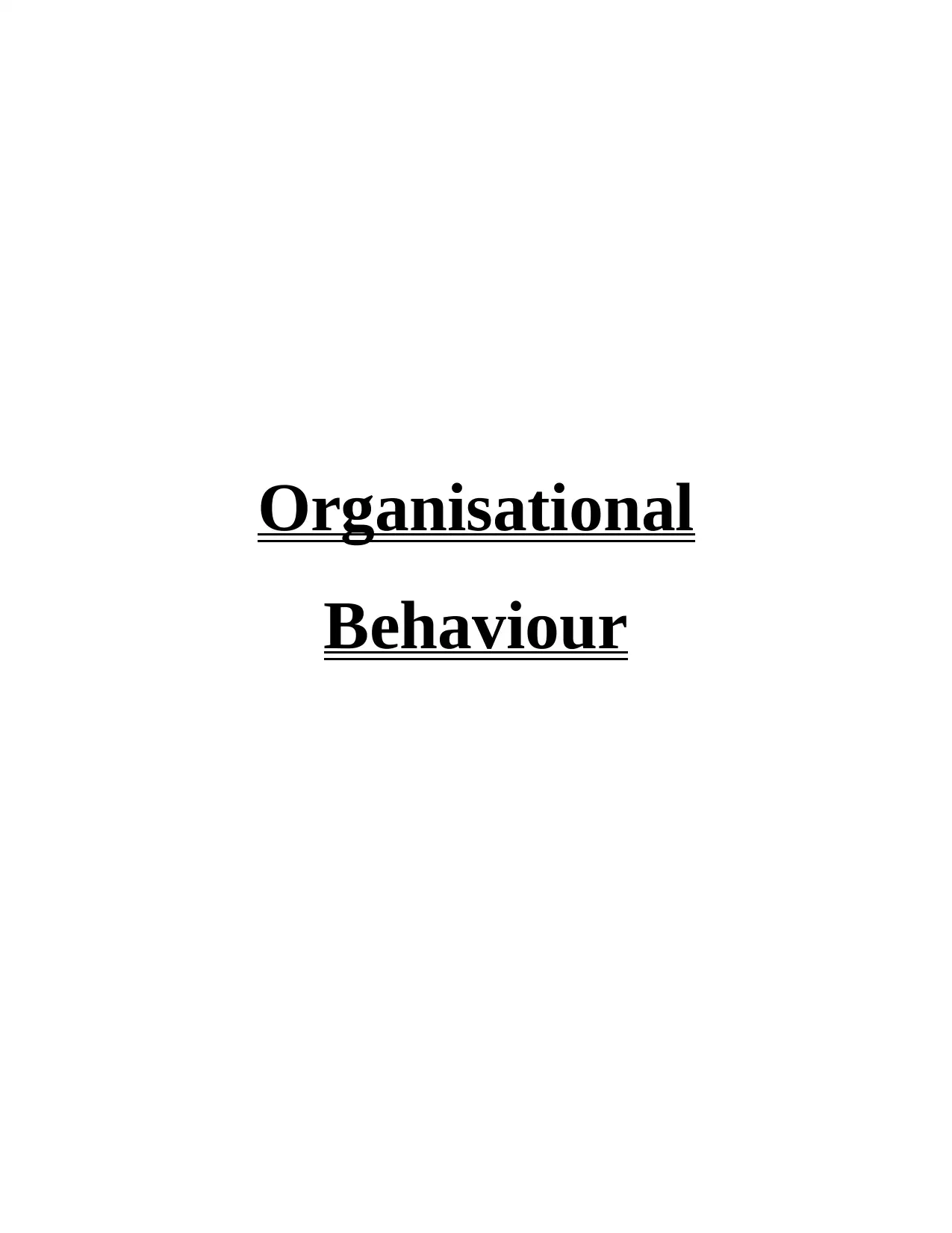
Organisational
Behaviour
Behaviour
Secure Best Marks with AI Grader
Need help grading? Try our AI Grader for instant feedback on your assignments.


EXECUTIVE SUMMARY
Organisational behaviour is concern with those aspect which is related with managing,
supervising and governing personnel capability or behaviour in order to accomplish business
goal or objective in an efficacious or expeditious manner. This report signifies about impact of
culture, politics and power over firm working condition as well as on its potentiality in acquiring
increased level of productivity. Moreover, application of various theories or concepts regarding
motivating team members and in achieving establishment vision in an innovative or creative
style within prescribed time period.
Organisational behaviour is concern with those aspect which is related with managing,
supervising and governing personnel capability or behaviour in order to accomplish business
goal or objective in an efficacious or expeditious manner. This report signifies about impact of
culture, politics and power over firm working condition as well as on its potentiality in acquiring
increased level of productivity. Moreover, application of various theories or concepts regarding
motivating team members and in achieving establishment vision in an innovative or creative
style within prescribed time period.
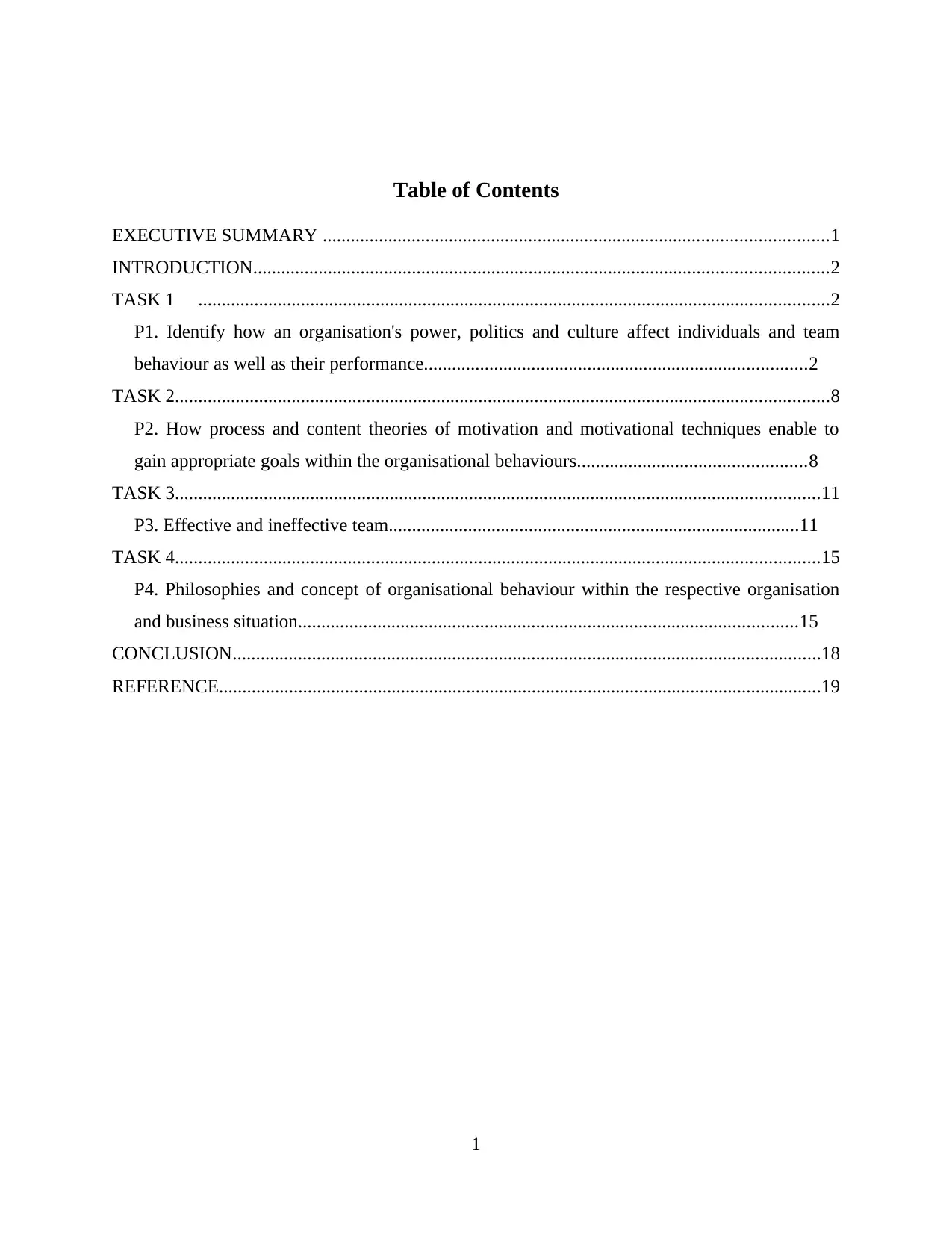
Table of Contents
EXECUTIVE SUMMARY ............................................................................................................1
INTRODUCTION...........................................................................................................................2
TASK 1 .......................................................................................................................................2
P1. Identify how an organisation's power, politics and culture affect individuals and team
behaviour as well as their performance..................................................................................2
TASK 2............................................................................................................................................8
P2. How process and content theories of motivation and motivational techniques enable to
gain appropriate goals within the organisational behaviours.................................................8
TASK 3..........................................................................................................................................11
P3. Effective and ineffective team........................................................................................11
TASK 4..........................................................................................................................................15
P4. Philosophies and concept of organisational behaviour within the respective organisation
and business situation...........................................................................................................15
CONCLUSION..............................................................................................................................18
REFERENCE.................................................................................................................................19
1
EXECUTIVE SUMMARY ............................................................................................................1
INTRODUCTION...........................................................................................................................2
TASK 1 .......................................................................................................................................2
P1. Identify how an organisation's power, politics and culture affect individuals and team
behaviour as well as their performance..................................................................................2
TASK 2............................................................................................................................................8
P2. How process and content theories of motivation and motivational techniques enable to
gain appropriate goals within the organisational behaviours.................................................8
TASK 3..........................................................................................................................................11
P3. Effective and ineffective team........................................................................................11
TASK 4..........................................................................................................................................15
P4. Philosophies and concept of organisational behaviour within the respective organisation
and business situation...........................................................................................................15
CONCLUSION..............................................................................................................................18
REFERENCE.................................................................................................................................19
1
Secure Best Marks with AI Grader
Need help grading? Try our AI Grader for instant feedback on your assignments.
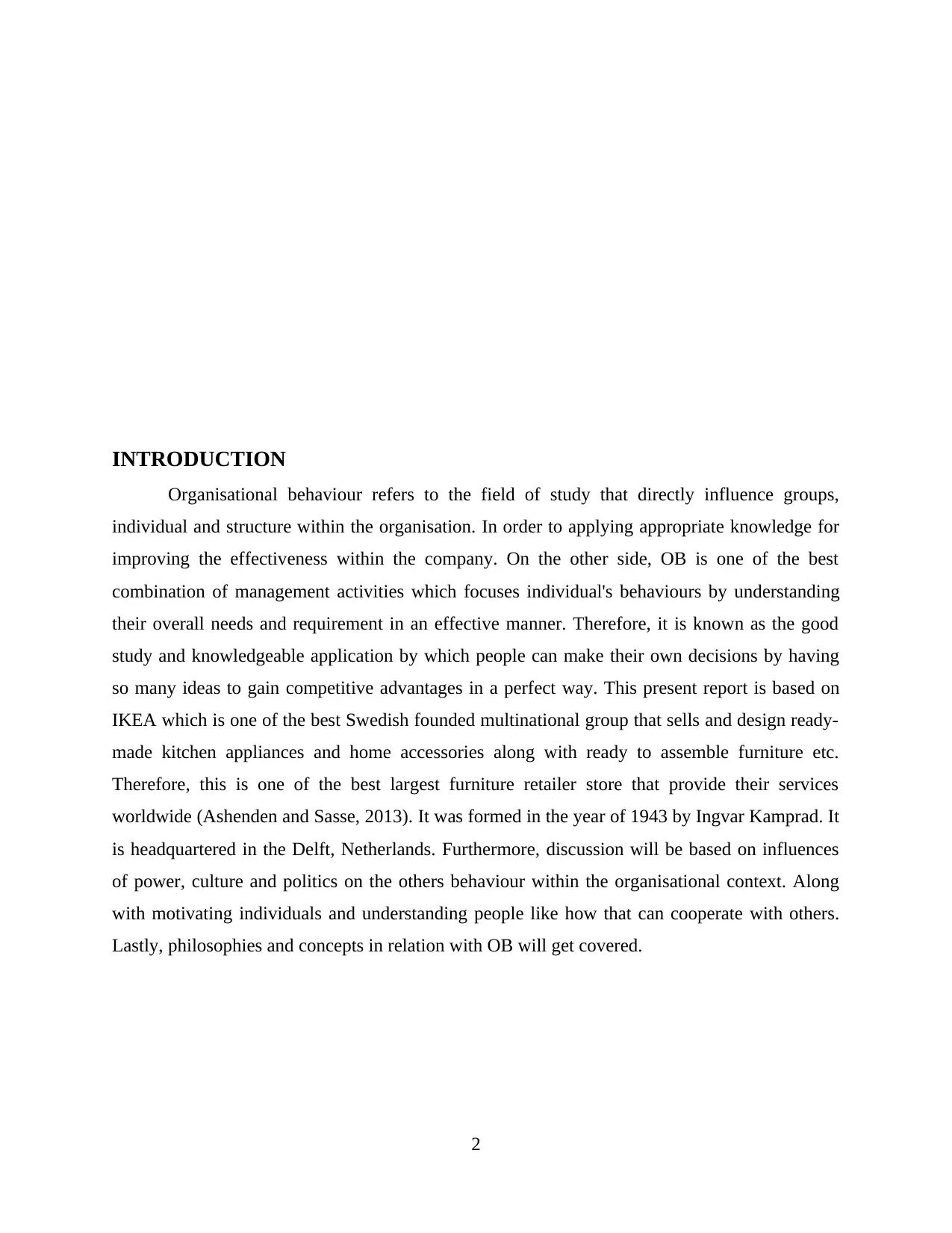
INTRODUCTION
Organisational behaviour refers to the field of study that directly influence groups,
individual and structure within the organisation. In order to applying appropriate knowledge for
improving the effectiveness within the company. On the other side, OB is one of the best
combination of management activities which focuses individual's behaviours by understanding
their overall needs and requirement in an effective manner. Therefore, it is known as the good
study and knowledgeable application by which people can make their own decisions by having
so many ideas to gain competitive advantages in a perfect way. This present report is based on
IKEA which is one of the best Swedish founded multinational group that sells and design ready-
made kitchen appliances and home accessories along with ready to assemble furniture etc.
Therefore, this is one of the best largest furniture retailer store that provide their services
worldwide (Ashenden and Sasse, 2013). It was formed in the year of 1943 by Ingvar Kamprad. It
is headquartered in the Delft, Netherlands. Furthermore, discussion will be based on influences
of power, culture and politics on the others behaviour within the organisational context. Along
with motivating individuals and understanding people like how that can cooperate with others.
Lastly, philosophies and concepts in relation with OB will get covered.
2
Organisational behaviour refers to the field of study that directly influence groups,
individual and structure within the organisation. In order to applying appropriate knowledge for
improving the effectiveness within the company. On the other side, OB is one of the best
combination of management activities which focuses individual's behaviours by understanding
their overall needs and requirement in an effective manner. Therefore, it is known as the good
study and knowledgeable application by which people can make their own decisions by having
so many ideas to gain competitive advantages in a perfect way. This present report is based on
IKEA which is one of the best Swedish founded multinational group that sells and design ready-
made kitchen appliances and home accessories along with ready to assemble furniture etc.
Therefore, this is one of the best largest furniture retailer store that provide their services
worldwide (Ashenden and Sasse, 2013). It was formed in the year of 1943 by Ingvar Kamprad. It
is headquartered in the Delft, Netherlands. Furthermore, discussion will be based on influences
of power, culture and politics on the others behaviour within the organisational context. Along
with motivating individuals and understanding people like how that can cooperate with others.
Lastly, philosophies and concepts in relation with OB will get covered.
2
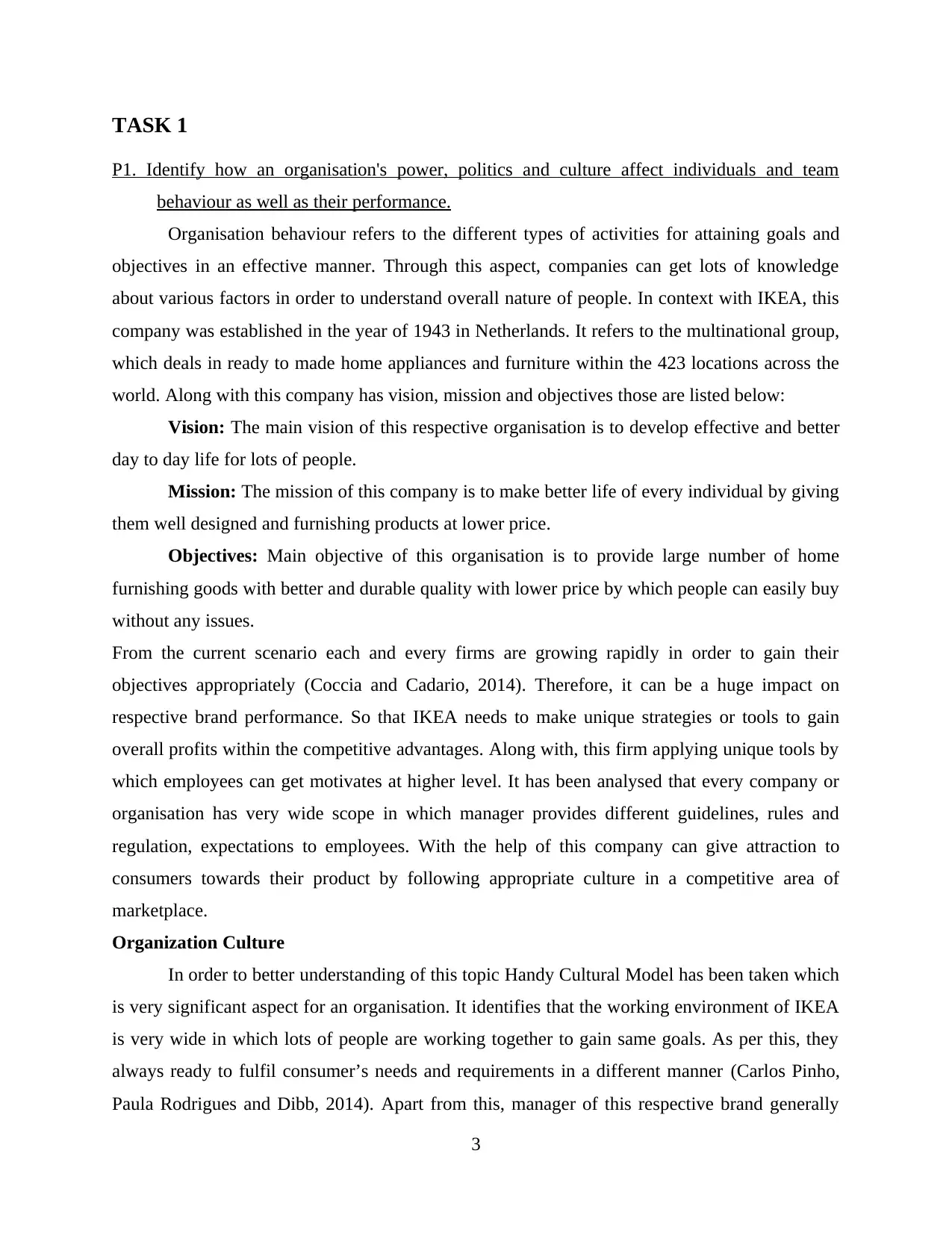
TASK 1
P1. Identify how an organisation's power, politics and culture affect individuals and team
behaviour as well as their performance.
Organisation behaviour refers to the different types of activities for attaining goals and
objectives in an effective manner. Through this aspect, companies can get lots of knowledge
about various factors in order to understand overall nature of people. In context with IKEA, this
company was established in the year of 1943 in Netherlands. It refers to the multinational group,
which deals in ready to made home appliances and furniture within the 423 locations across the
world. Along with this company has vision, mission and objectives those are listed below:
Vision: The main vision of this respective organisation is to develop effective and better
day to day life for lots of people.
Mission: The mission of this company is to make better life of every individual by giving
them well designed and furnishing products at lower price.
Objectives: Main objective of this organisation is to provide large number of home
furnishing goods with better and durable quality with lower price by which people can easily buy
without any issues.
From the current scenario each and every firms are growing rapidly in order to gain their
objectives appropriately (Coccia and Cadario, 2014). Therefore, it can be a huge impact on
respective brand performance. So that IKEA needs to make unique strategies or tools to gain
overall profits within the competitive advantages. Along with, this firm applying unique tools by
which employees can get motivates at higher level. It has been analysed that every company or
organisation has very wide scope in which manager provides different guidelines, rules and
regulation, expectations to employees. With the help of this company can give attraction to
consumers towards their product by following appropriate culture in a competitive area of
marketplace.
Organization Culture
In order to better understanding of this topic Handy Cultural Model has been taken which
is very significant aspect for an organisation. It identifies that the working environment of IKEA
is very wide in which lots of people are working together to gain same goals. As per this, they
always ready to fulfil consumer’s needs and requirements in a different manner (Carlos Pinho,
Paula Rodrigues and Dibb, 2014). Apart from this, manager of this respective brand generally
3
P1. Identify how an organisation's power, politics and culture affect individuals and team
behaviour as well as their performance.
Organisation behaviour refers to the different types of activities for attaining goals and
objectives in an effective manner. Through this aspect, companies can get lots of knowledge
about various factors in order to understand overall nature of people. In context with IKEA, this
company was established in the year of 1943 in Netherlands. It refers to the multinational group,
which deals in ready to made home appliances and furniture within the 423 locations across the
world. Along with this company has vision, mission and objectives those are listed below:
Vision: The main vision of this respective organisation is to develop effective and better
day to day life for lots of people.
Mission: The mission of this company is to make better life of every individual by giving
them well designed and furnishing products at lower price.
Objectives: Main objective of this organisation is to provide large number of home
furnishing goods with better and durable quality with lower price by which people can easily buy
without any issues.
From the current scenario each and every firms are growing rapidly in order to gain their
objectives appropriately (Coccia and Cadario, 2014). Therefore, it can be a huge impact on
respective brand performance. So that IKEA needs to make unique strategies or tools to gain
overall profits within the competitive advantages. Along with, this firm applying unique tools by
which employees can get motivates at higher level. It has been analysed that every company or
organisation has very wide scope in which manager provides different guidelines, rules and
regulation, expectations to employees. With the help of this company can give attraction to
consumers towards their product by following appropriate culture in a competitive area of
marketplace.
Organization Culture
In order to better understanding of this topic Handy Cultural Model has been taken which
is very significant aspect for an organisation. It identifies that the working environment of IKEA
is very wide in which lots of people are working together to gain same goals. As per this, they
always ready to fulfil consumer’s needs and requirements in a different manner (Carlos Pinho,
Paula Rodrigues and Dibb, 2014). Apart from this, manager of this respective brand generally
3
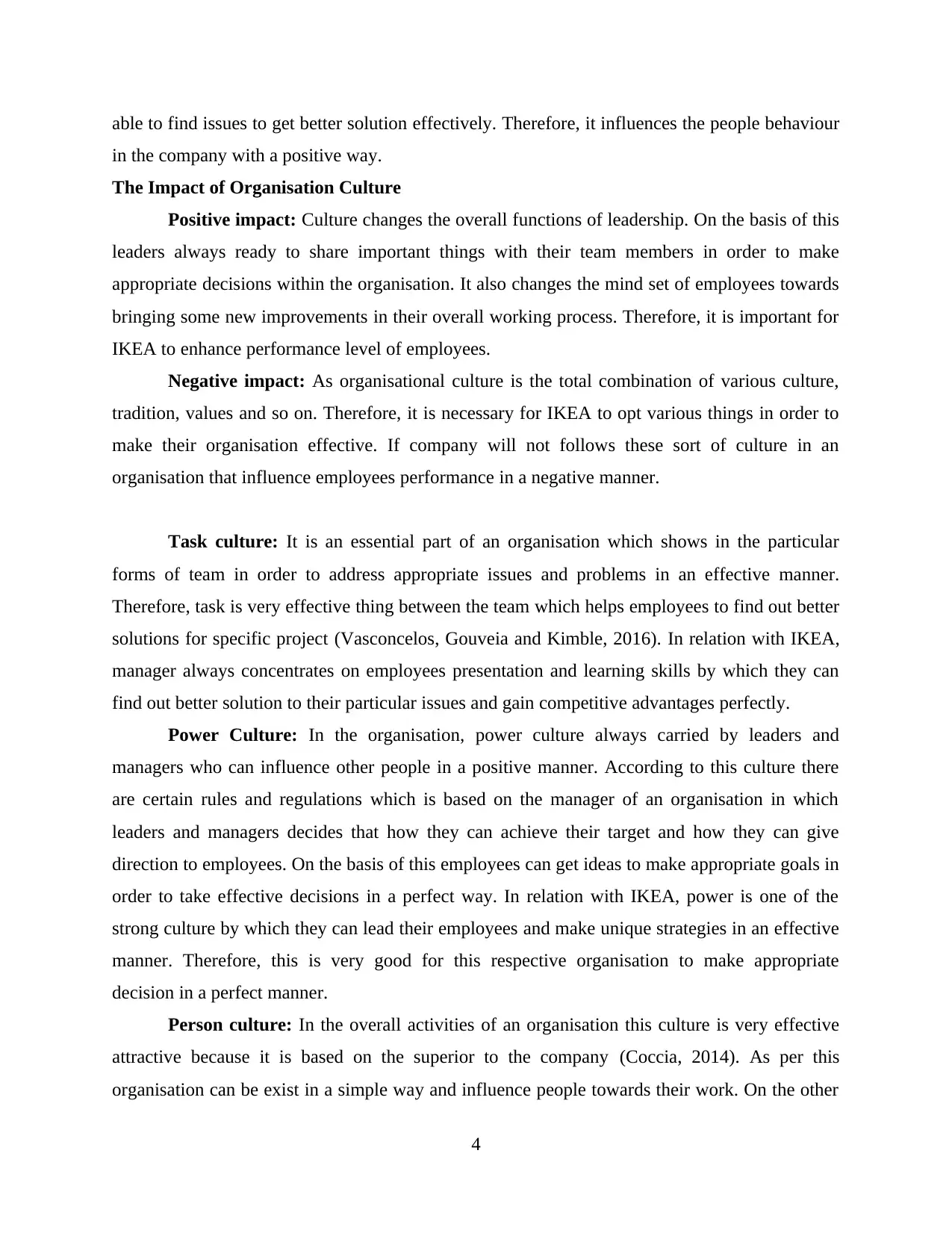
able to find issues to get better solution effectively. Therefore, it influences the people behaviour
in the company with a positive way.
The Impact of Organisation Culture
Positive impact: Culture changes the overall functions of leadership. On the basis of this
leaders always ready to share important things with their team members in order to make
appropriate decisions within the organisation. It also changes the mind set of employees towards
bringing some new improvements in their overall working process. Therefore, it is important for
IKEA to enhance performance level of employees.
Negative impact: As organisational culture is the total combination of various culture,
tradition, values and so on. Therefore, it is necessary for IKEA to opt various things in order to
make their organisation effective. If company will not follows these sort of culture in an
organisation that influence employees performance in a negative manner.
Task culture: It is an essential part of an organisation which shows in the particular
forms of team in order to address appropriate issues and problems in an effective manner.
Therefore, task is very effective thing between the team which helps employees to find out better
solutions for specific project (Vasconcelos, Gouveia and Kimble, 2016). In relation with IKEA,
manager always concentrates on employees presentation and learning skills by which they can
find out better solution to their particular issues and gain competitive advantages perfectly.
Power Culture: In the organisation, power culture always carried by leaders and
managers who can influence other people in a positive manner. According to this culture there
are certain rules and regulations which is based on the manager of an organisation in which
leaders and managers decides that how they can achieve their target and how they can give
direction to employees. On the basis of this employees can get ideas to make appropriate goals in
order to take effective decisions in a perfect way. In relation with IKEA, power is one of the
strong culture by which they can lead their employees and make unique strategies in an effective
manner. Therefore, this is very good for this respective organisation to make appropriate
decision in a perfect manner.
Person culture: In the overall activities of an organisation this culture is very effective
attractive because it is based on the superior to the company (Coccia, 2014). As per this
organisation can be exist in a simple way and influence people towards their work. On the other
4
in the company with a positive way.
The Impact of Organisation Culture
Positive impact: Culture changes the overall functions of leadership. On the basis of this
leaders always ready to share important things with their team members in order to make
appropriate decisions within the organisation. It also changes the mind set of employees towards
bringing some new improvements in their overall working process. Therefore, it is important for
IKEA to enhance performance level of employees.
Negative impact: As organisational culture is the total combination of various culture,
tradition, values and so on. Therefore, it is necessary for IKEA to opt various things in order to
make their organisation effective. If company will not follows these sort of culture in an
organisation that influence employees performance in a negative manner.
Task culture: It is an essential part of an organisation which shows in the particular
forms of team in order to address appropriate issues and problems in an effective manner.
Therefore, task is very effective thing between the team which helps employees to find out better
solutions for specific project (Vasconcelos, Gouveia and Kimble, 2016). In relation with IKEA,
manager always concentrates on employees presentation and learning skills by which they can
find out better solution to their particular issues and gain competitive advantages perfectly.
Power Culture: In the organisation, power culture always carried by leaders and
managers who can influence other people in a positive manner. According to this culture there
are certain rules and regulations which is based on the manager of an organisation in which
leaders and managers decides that how they can achieve their target and how they can give
direction to employees. On the basis of this employees can get ideas to make appropriate goals in
order to take effective decisions in a perfect way. In relation with IKEA, power is one of the
strong culture by which they can lead their employees and make unique strategies in an effective
manner. Therefore, this is very good for this respective organisation to make appropriate
decision in a perfect manner.
Person culture: In the overall activities of an organisation this culture is very effective
attractive because it is based on the superior to the company (Coccia, 2014). As per this
organisation can be exist in a simple way and influence people towards their work. On the other
4
Paraphrase This Document
Need a fresh take? Get an instant paraphrase of this document with our AI Paraphraser
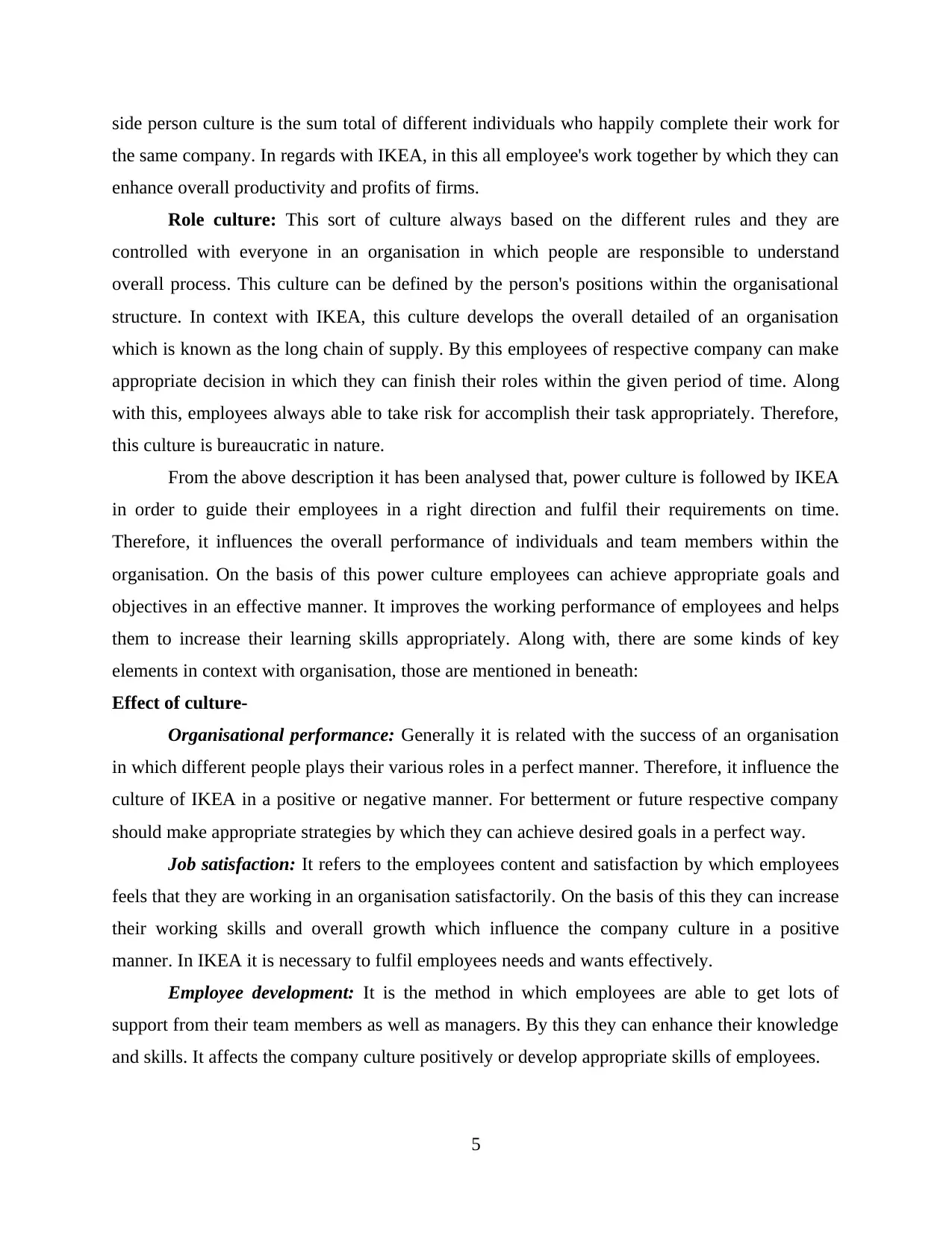
side person culture is the sum total of different individuals who happily complete their work for
the same company. In regards with IKEA, in this all employee's work together by which they can
enhance overall productivity and profits of firms.
Role culture: This sort of culture always based on the different rules and they are
controlled with everyone in an organisation in which people are responsible to understand
overall process. This culture can be defined by the person's positions within the organisational
structure. In context with IKEA, this culture develops the overall detailed of an organisation
which is known as the long chain of supply. By this employees of respective company can make
appropriate decision in which they can finish their roles within the given period of time. Along
with this, employees always able to take risk for accomplish their task appropriately. Therefore,
this culture is bureaucratic in nature.
From the above description it has been analysed that, power culture is followed by IKEA
in order to guide their employees in a right direction and fulfil their requirements on time.
Therefore, it influences the overall performance of individuals and team members within the
organisation. On the basis of this power culture employees can achieve appropriate goals and
objectives in an effective manner. It improves the working performance of employees and helps
them to increase their learning skills appropriately. Along with, there are some kinds of key
elements in context with organisation, those are mentioned in beneath:
Effect of culture-
Organisational performance: Generally it is related with the success of an organisation
in which different people plays their various roles in a perfect manner. Therefore, it influence the
culture of IKEA in a positive or negative manner. For betterment or future respective company
should make appropriate strategies by which they can achieve desired goals in a perfect way.
Job satisfaction: It refers to the employees content and satisfaction by which employees
feels that they are working in an organisation satisfactorily. On the basis of this they can increase
their working skills and overall growth which influence the company culture in a positive
manner. In IKEA it is necessary to fulfil employees needs and wants effectively.
Employee development: It is the method in which employees are able to get lots of
support from their team members as well as managers. By this they can enhance their knowledge
and skills. It affects the company culture positively or develop appropriate skills of employees.
5
the same company. In regards with IKEA, in this all employee's work together by which they can
enhance overall productivity and profits of firms.
Role culture: This sort of culture always based on the different rules and they are
controlled with everyone in an organisation in which people are responsible to understand
overall process. This culture can be defined by the person's positions within the organisational
structure. In context with IKEA, this culture develops the overall detailed of an organisation
which is known as the long chain of supply. By this employees of respective company can make
appropriate decision in which they can finish their roles within the given period of time. Along
with this, employees always able to take risk for accomplish their task appropriately. Therefore,
this culture is bureaucratic in nature.
From the above description it has been analysed that, power culture is followed by IKEA
in order to guide their employees in a right direction and fulfil their requirements on time.
Therefore, it influences the overall performance of individuals and team members within the
organisation. On the basis of this power culture employees can achieve appropriate goals and
objectives in an effective manner. It improves the working performance of employees and helps
them to increase their learning skills appropriately. Along with, there are some kinds of key
elements in context with organisation, those are mentioned in beneath:
Effect of culture-
Organisational performance: Generally it is related with the success of an organisation
in which different people plays their various roles in a perfect manner. Therefore, it influence the
culture of IKEA in a positive or negative manner. For betterment or future respective company
should make appropriate strategies by which they can achieve desired goals in a perfect way.
Job satisfaction: It refers to the employees content and satisfaction by which employees
feels that they are working in an organisation satisfactorily. On the basis of this they can increase
their working skills and overall growth which influence the company culture in a positive
manner. In IKEA it is necessary to fulfil employees needs and wants effectively.
Employee development: It is the method in which employees are able to get lots of
support from their team members as well as managers. By this they can enhance their knowledge
and skills. It affects the company culture positively or develop appropriate skills of employees.
5
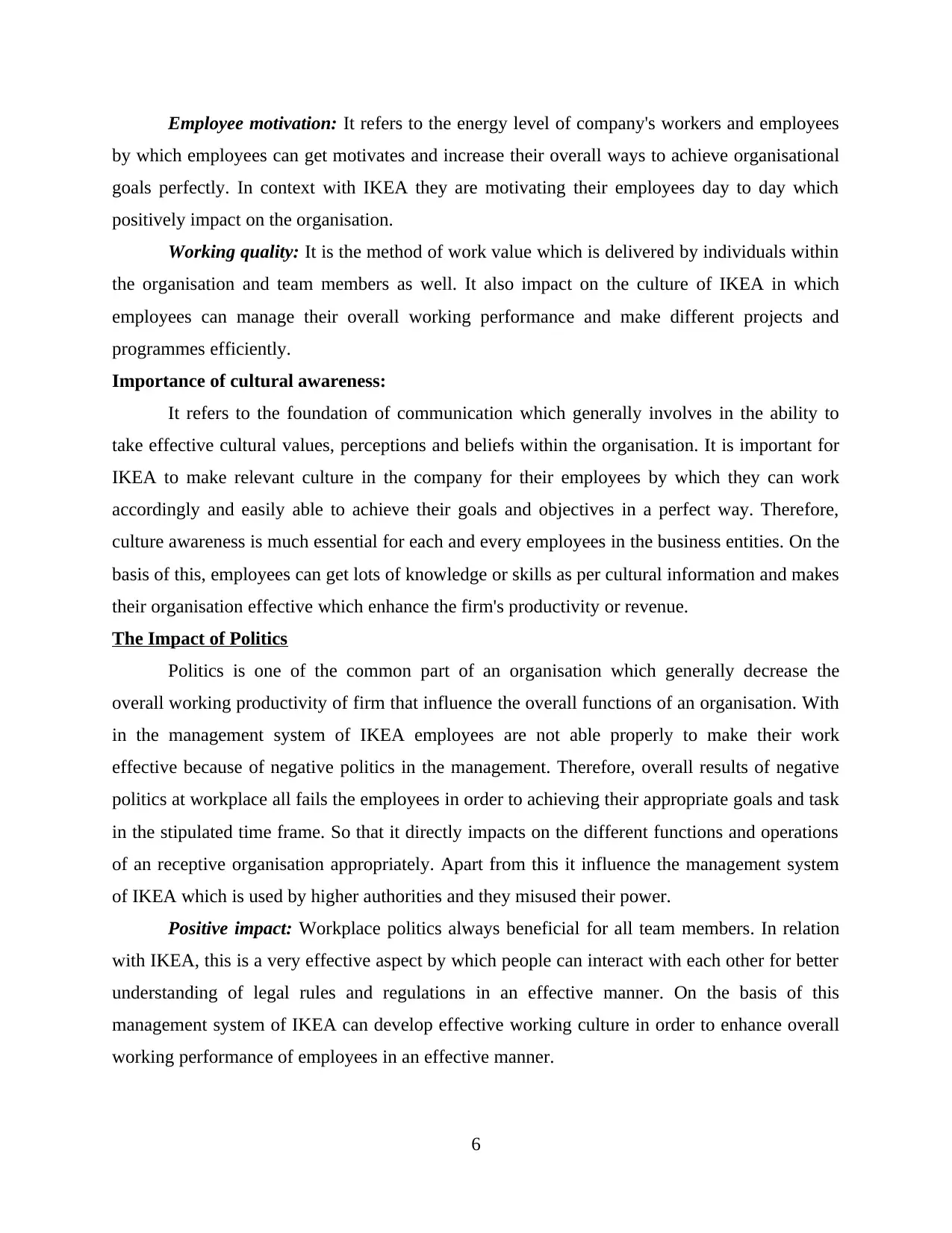
Employee motivation: It refers to the energy level of company's workers and employees
by which employees can get motivates and increase their overall ways to achieve organisational
goals perfectly. In context with IKEA they are motivating their employees day to day which
positively impact on the organisation.
Working quality: It is the method of work value which is delivered by individuals within
the organisation and team members as well. It also impact on the culture of IKEA in which
employees can manage their overall working performance and make different projects and
programmes efficiently.
Importance of cultural awareness:
It refers to the foundation of communication which generally involves in the ability to
take effective cultural values, perceptions and beliefs within the organisation. It is important for
IKEA to make relevant culture in the company for their employees by which they can work
accordingly and easily able to achieve their goals and objectives in a perfect way. Therefore,
culture awareness is much essential for each and every employees in the business entities. On the
basis of this, employees can get lots of knowledge or skills as per cultural information and makes
their organisation effective which enhance the firm's productivity or revenue.
The Impact of Politics
Politics is one of the common part of an organisation which generally decrease the
overall working productivity of firm that influence the overall functions of an organisation. With
in the management system of IKEA employees are not able properly to make their work
effective because of negative politics in the management. Therefore, overall results of negative
politics at workplace all fails the employees in order to achieving their appropriate goals and task
in the stipulated time frame. So that it directly impacts on the different functions and operations
of an receptive organisation appropriately. Apart from this it influence the management system
of IKEA which is used by higher authorities and they misused their power.
Positive impact: Workplace politics always beneficial for all team members. In relation
with IKEA, this is a very effective aspect by which people can interact with each other for better
understanding of legal rules and regulations in an effective manner. On the basis of this
management system of IKEA can develop effective working culture in order to enhance overall
working performance of employees in an effective manner.
6
by which employees can get motivates and increase their overall ways to achieve organisational
goals perfectly. In context with IKEA they are motivating their employees day to day which
positively impact on the organisation.
Working quality: It is the method of work value which is delivered by individuals within
the organisation and team members as well. It also impact on the culture of IKEA in which
employees can manage their overall working performance and make different projects and
programmes efficiently.
Importance of cultural awareness:
It refers to the foundation of communication which generally involves in the ability to
take effective cultural values, perceptions and beliefs within the organisation. It is important for
IKEA to make relevant culture in the company for their employees by which they can work
accordingly and easily able to achieve their goals and objectives in a perfect way. Therefore,
culture awareness is much essential for each and every employees in the business entities. On the
basis of this, employees can get lots of knowledge or skills as per cultural information and makes
their organisation effective which enhance the firm's productivity or revenue.
The Impact of Politics
Politics is one of the common part of an organisation which generally decrease the
overall working productivity of firm that influence the overall functions of an organisation. With
in the management system of IKEA employees are not able properly to make their work
effective because of negative politics in the management. Therefore, overall results of negative
politics at workplace all fails the employees in order to achieving their appropriate goals and task
in the stipulated time frame. So that it directly impacts on the different functions and operations
of an receptive organisation appropriately. Apart from this it influence the management system
of IKEA which is used by higher authorities and they misused their power.
Positive impact: Workplace politics always beneficial for all team members. In relation
with IKEA, this is a very effective aspect by which people can interact with each other for better
understanding of legal rules and regulations in an effective manner. On the basis of this
management system of IKEA can develop effective working culture in order to enhance overall
working performance of employees in an effective manner.
6

Negative impact: In an organisation politics is one of the measure issue which directly
influence the performance of employees in a negative way. Due to some issues in the
organisation employees can get face so many problems by which they are not able to focuses on
their goals.
The Impact of Power
In the current period of time every organisation have different kinds of leader and
managers who have the power to motivate their employees and allotted various task to them with
the specific time limit. On the basis of this employees can learn so many things like how they
can complete their task in the short period of time and so on. Therefore, power influence each
and every people in an organisation. By which company can achieve their targeted goals and
objectives in a appropriate manner. In order to make better power impact on individuals and
employees IKEA applying effective employees development, work quality programmes etc. with
the help of this employees can get better knowledge of working quality and new techniques
which is necessary for attaining appropriate goals. Therefore, it influence working ability of
employees in a positive manner.
Positive Impact: According to IKEA, power have very good impact on the employees or
team members as this company conducting different kinds of training and developing
programmes for increasing appropriate knowledge or skills to gain better outcomes within the
organisation.
Negative Impact: If IKEA will not follow the various kind of aspects for their employees
so that they can feel bad and not able to achieve their goals perfectly. It reduces the firms
productivity and sales effectively.
Reward power: It refers to the power which is based on the manager in order to give
different kinds of reward and benefits system to employees in a perfect way. Along with this
reward can be tangible or intangible. In reference with IKEA, manager always provide discounts,
holiday package and club membership to their employees as per their overall performance. It
enhances their working level in the company which influence other people also.
Coercive Power: It is the process to ability of managers and leaders in order to give
some instructions for employees towards their work. In reference with IKEA, leaders are using
7
influence the performance of employees in a negative way. Due to some issues in the
organisation employees can get face so many problems by which they are not able to focuses on
their goals.
The Impact of Power
In the current period of time every organisation have different kinds of leader and
managers who have the power to motivate their employees and allotted various task to them with
the specific time limit. On the basis of this employees can learn so many things like how they
can complete their task in the short period of time and so on. Therefore, power influence each
and every people in an organisation. By which company can achieve their targeted goals and
objectives in a appropriate manner. In order to make better power impact on individuals and
employees IKEA applying effective employees development, work quality programmes etc. with
the help of this employees can get better knowledge of working quality and new techniques
which is necessary for attaining appropriate goals. Therefore, it influence working ability of
employees in a positive manner.
Positive Impact: According to IKEA, power have very good impact on the employees or
team members as this company conducting different kinds of training and developing
programmes for increasing appropriate knowledge or skills to gain better outcomes within the
organisation.
Negative Impact: If IKEA will not follow the various kind of aspects for their employees
so that they can feel bad and not able to achieve their goals perfectly. It reduces the firms
productivity and sales effectively.
Reward power: It refers to the power which is based on the manager in order to give
different kinds of reward and benefits system to employees in a perfect way. Along with this
reward can be tangible or intangible. In reference with IKEA, manager always provide discounts,
holiday package and club membership to their employees as per their overall performance. It
enhances their working level in the company which influence other people also.
Coercive Power: It is the process to ability of managers and leaders in order to give
some instructions for employees towards their work. In reference with IKEA, leaders are using
7
Secure Best Marks with AI Grader
Need help grading? Try our AI Grader for instant feedback on your assignments.
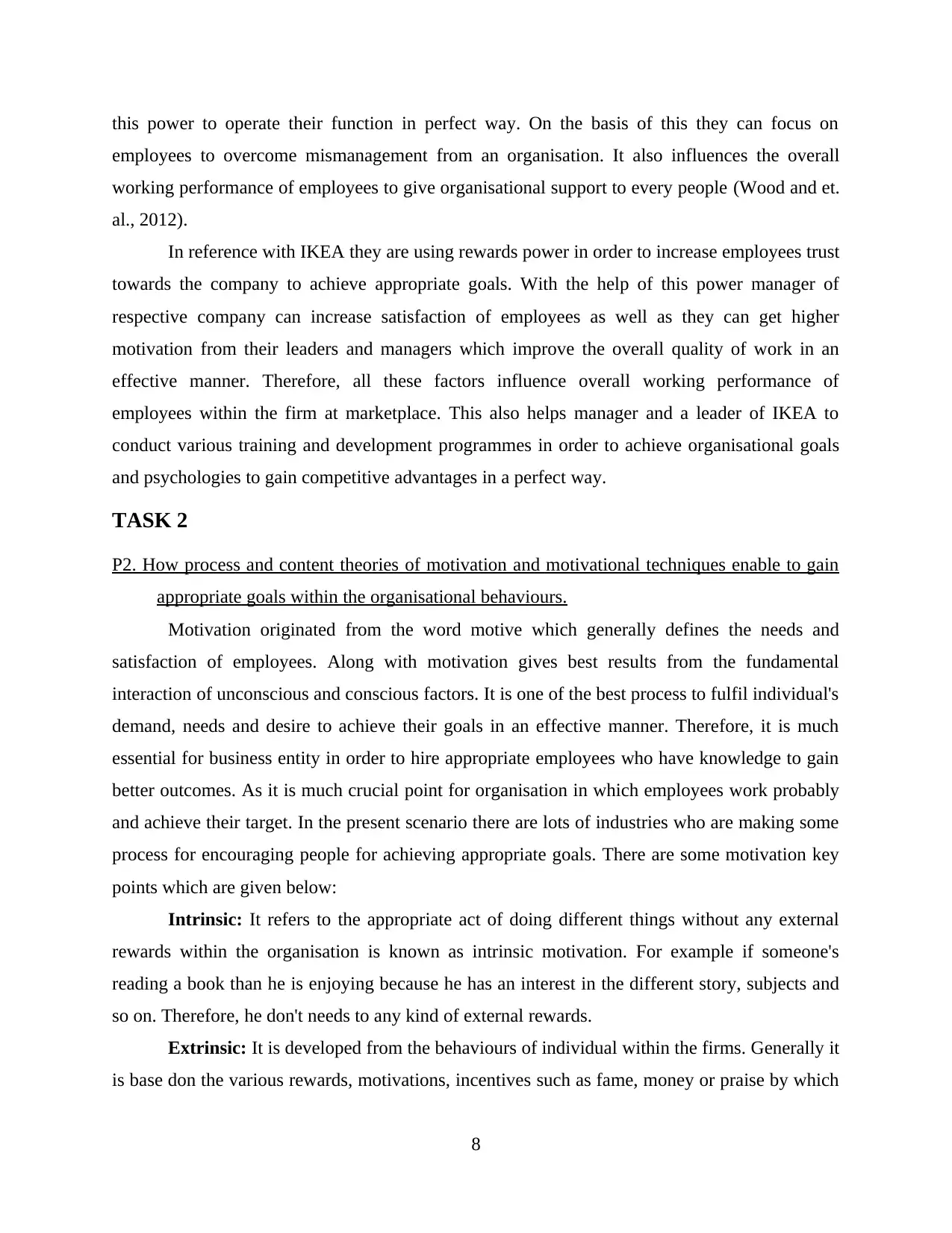
this power to operate their function in perfect way. On the basis of this they can focus on
employees to overcome mismanagement from an organisation. It also influences the overall
working performance of employees to give organisational support to every people (Wood and et.
al., 2012).
In reference with IKEA they are using rewards power in order to increase employees trust
towards the company to achieve appropriate goals. With the help of this power manager of
respective company can increase satisfaction of employees as well as they can get higher
motivation from their leaders and managers which improve the overall quality of work in an
effective manner. Therefore, all these factors influence overall working performance of
employees within the firm at marketplace. This also helps manager and a leader of IKEA to
conduct various training and development programmes in order to achieve organisational goals
and psychologies to gain competitive advantages in a perfect way.
TASK 2
P2. How process and content theories of motivation and motivational techniques enable to gain
appropriate goals within the organisational behaviours.
Motivation originated from the word motive which generally defines the needs and
satisfaction of employees. Along with motivation gives best results from the fundamental
interaction of unconscious and conscious factors. It is one of the best process to fulfil individual's
demand, needs and desire to achieve their goals in an effective manner. Therefore, it is much
essential for business entity in order to hire appropriate employees who have knowledge to gain
better outcomes. As it is much crucial point for organisation in which employees work probably
and achieve their target. In the present scenario there are lots of industries who are making some
process for encouraging people for achieving appropriate goals. There are some motivation key
points which are given below:
Intrinsic: It refers to the appropriate act of doing different things without any external
rewards within the organisation is known as intrinsic motivation. For example if someone's
reading a book than he is enjoying because he has an interest in the different story, subjects and
so on. Therefore, he don't needs to any kind of external rewards.
Extrinsic: It is developed from the behaviours of individual within the firms. Generally it
is base don the various rewards, motivations, incentives such as fame, money or praise by which
8
employees to overcome mismanagement from an organisation. It also influences the overall
working performance of employees to give organisational support to every people (Wood and et.
al., 2012).
In reference with IKEA they are using rewards power in order to increase employees trust
towards the company to achieve appropriate goals. With the help of this power manager of
respective company can increase satisfaction of employees as well as they can get higher
motivation from their leaders and managers which improve the overall quality of work in an
effective manner. Therefore, all these factors influence overall working performance of
employees within the firm at marketplace. This also helps manager and a leader of IKEA to
conduct various training and development programmes in order to achieve organisational goals
and psychologies to gain competitive advantages in a perfect way.
TASK 2
P2. How process and content theories of motivation and motivational techniques enable to gain
appropriate goals within the organisational behaviours.
Motivation originated from the word motive which generally defines the needs and
satisfaction of employees. Along with motivation gives best results from the fundamental
interaction of unconscious and conscious factors. It is one of the best process to fulfil individual's
demand, needs and desire to achieve their goals in an effective manner. Therefore, it is much
essential for business entity in order to hire appropriate employees who have knowledge to gain
better outcomes. As it is much crucial point for organisation in which employees work probably
and achieve their target. In the present scenario there are lots of industries who are making some
process for encouraging people for achieving appropriate goals. There are some motivation key
points which are given below:
Intrinsic: It refers to the appropriate act of doing different things without any external
rewards within the organisation is known as intrinsic motivation. For example if someone's
reading a book than he is enjoying because he has an interest in the different story, subjects and
so on. Therefore, he don't needs to any kind of external rewards.
Extrinsic: It is developed from the behaviours of individual within the firms. Generally it
is base don the various rewards, motivations, incentives such as fame, money or praise by which
8
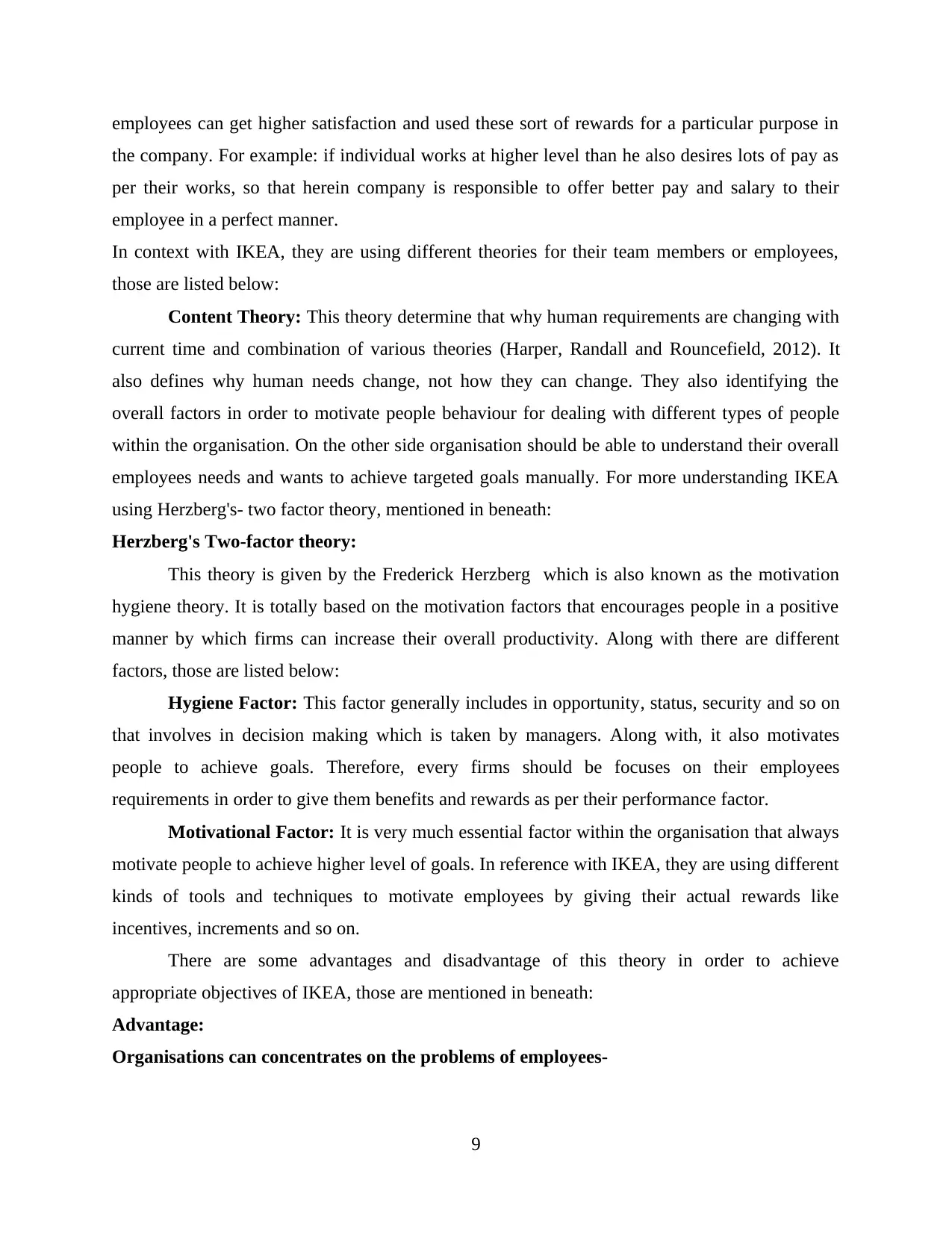
employees can get higher satisfaction and used these sort of rewards for a particular purpose in
the company. For example: if individual works at higher level than he also desires lots of pay as
per their works, so that herein company is responsible to offer better pay and salary to their
employee in a perfect manner.
In context with IKEA, they are using different theories for their team members or employees,
those are listed below:
Content Theory: This theory determine that why human requirements are changing with
current time and combination of various theories (Harper, Randall and Rouncefield, 2012). It
also defines why human needs change, not how they can change. They also identifying the
overall factors in order to motivate people behaviour for dealing with different types of people
within the organisation. On the other side organisation should be able to understand their overall
employees needs and wants to achieve targeted goals manually. For more understanding IKEA
using Herzberg's- two factor theory, mentioned in beneath:
Herzberg's Two-factor theory:
This theory is given by the Frederick Herzberg which is also known as the motivation
hygiene theory. It is totally based on the motivation factors that encourages people in a positive
manner by which firms can increase their overall productivity. Along with there are different
factors, those are listed below:
Hygiene Factor: This factor generally includes in opportunity, status, security and so on
that involves in decision making which is taken by managers. Along with, it also motivates
people to achieve goals. Therefore, every firms should be focuses on their employees
requirements in order to give them benefits and rewards as per their performance factor.
Motivational Factor: It is very much essential factor within the organisation that always
motivate people to achieve higher level of goals. In reference with IKEA, they are using different
kinds of tools and techniques to motivate employees by giving their actual rewards like
incentives, increments and so on.
There are some advantages and disadvantage of this theory in order to achieve
appropriate objectives of IKEA, those are mentioned in beneath:
Advantage:
Organisations can concentrates on the problems of employees-
9
the company. For example: if individual works at higher level than he also desires lots of pay as
per their works, so that herein company is responsible to offer better pay and salary to their
employee in a perfect manner.
In context with IKEA, they are using different theories for their team members or employees,
those are listed below:
Content Theory: This theory determine that why human requirements are changing with
current time and combination of various theories (Harper, Randall and Rouncefield, 2012). It
also defines why human needs change, not how they can change. They also identifying the
overall factors in order to motivate people behaviour for dealing with different types of people
within the organisation. On the other side organisation should be able to understand their overall
employees needs and wants to achieve targeted goals manually. For more understanding IKEA
using Herzberg's- two factor theory, mentioned in beneath:
Herzberg's Two-factor theory:
This theory is given by the Frederick Herzberg which is also known as the motivation
hygiene theory. It is totally based on the motivation factors that encourages people in a positive
manner by which firms can increase their overall productivity. Along with there are different
factors, those are listed below:
Hygiene Factor: This factor generally includes in opportunity, status, security and so on
that involves in decision making which is taken by managers. Along with, it also motivates
people to achieve goals. Therefore, every firms should be focuses on their employees
requirements in order to give them benefits and rewards as per their performance factor.
Motivational Factor: It is very much essential factor within the organisation that always
motivate people to achieve higher level of goals. In reference with IKEA, they are using different
kinds of tools and techniques to motivate employees by giving their actual rewards like
incentives, increments and so on.
There are some advantages and disadvantage of this theory in order to achieve
appropriate objectives of IKEA, those are mentioned in beneath:
Advantage:
Organisations can concentrates on the problems of employees-
9
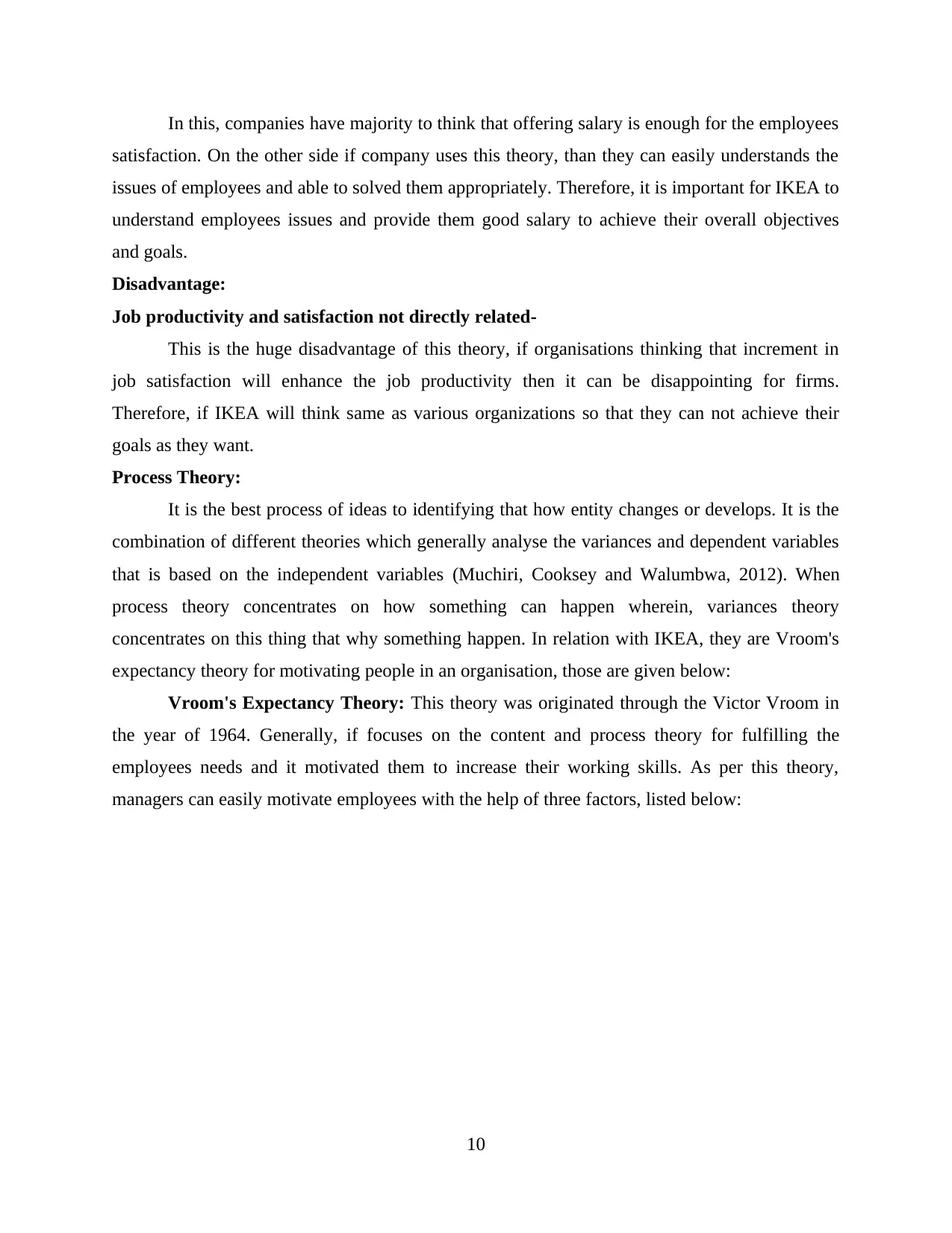
In this, companies have majority to think that offering salary is enough for the employees
satisfaction. On the other side if company uses this theory, than they can easily understands the
issues of employees and able to solved them appropriately. Therefore, it is important for IKEA to
understand employees issues and provide them good salary to achieve their overall objectives
and goals.
Disadvantage:
Job productivity and satisfaction not directly related-
This is the huge disadvantage of this theory, if organisations thinking that increment in
job satisfaction will enhance the job productivity then it can be disappointing for firms.
Therefore, if IKEA will think same as various organizations so that they can not achieve their
goals as they want.
Process Theory:
It is the best process of ideas to identifying that how entity changes or develops. It is the
combination of different theories which generally analyse the variances and dependent variables
that is based on the independent variables (Muchiri, Cooksey and Walumbwa, 2012). When
process theory concentrates on how something can happen wherein, variances theory
concentrates on this thing that why something happen. In relation with IKEA, they are Vroom's
expectancy theory for motivating people in an organisation, those are given below:
Vroom's Expectancy Theory: This theory was originated through the Victor Vroom in
the year of 1964. Generally, if focuses on the content and process theory for fulfilling the
employees needs and it motivated them to increase their working skills. As per this theory,
managers can easily motivate employees with the help of three factors, listed below:
10
satisfaction. On the other side if company uses this theory, than they can easily understands the
issues of employees and able to solved them appropriately. Therefore, it is important for IKEA to
understand employees issues and provide them good salary to achieve their overall objectives
and goals.
Disadvantage:
Job productivity and satisfaction not directly related-
This is the huge disadvantage of this theory, if organisations thinking that increment in
job satisfaction will enhance the job productivity then it can be disappointing for firms.
Therefore, if IKEA will think same as various organizations so that they can not achieve their
goals as they want.
Process Theory:
It is the best process of ideas to identifying that how entity changes or develops. It is the
combination of different theories which generally analyse the variances and dependent variables
that is based on the independent variables (Muchiri, Cooksey and Walumbwa, 2012). When
process theory concentrates on how something can happen wherein, variances theory
concentrates on this thing that why something happen. In relation with IKEA, they are Vroom's
expectancy theory for motivating people in an organisation, those are given below:
Vroom's Expectancy Theory: This theory was originated through the Victor Vroom in
the year of 1964. Generally, if focuses on the content and process theory for fulfilling the
employees needs and it motivated them to increase their working skills. As per this theory,
managers can easily motivate employees with the help of three factors, listed below:
10
Paraphrase This Document
Need a fresh take? Get an instant paraphrase of this document with our AI Paraphraser

Illustration: 1 Vroom's Expectancy Theory
Source: Vroom's Expectancy Theory 2019
Expectancy: This factor of theory generally includes in the motivation to employees by
which they can work accordingly and impact on the IKEA functions in a positive way for
increasing overall performance of employees.
Instrumentality: According to this leaders and managers are always develop clear
understanding and good relationship between the outcomes and performance by which they can
achieve appropriate goals in an effective manner (Process theories of motivation. 2009-2019).
Valence: It refers to the perceived value in which employees are responsible to achieve
effective outcomes. It is very positive value that helps persons to attaining their goals. Like
sometimes people can be influence by money and any other aspects which help them to achieve
appropriate goals in an effective manner. Therefore, all these are necessary for IKEA to followed
them in order to motivate employees in a perfect way (Vroom's Expectency Theory, 2019).
Advantages:
The main advantage of this theory is employees expectation can be easily increased by
getting various rewards and incentives from an organisation. As it is the very much effective
11
Source: Vroom's Expectancy Theory 2019
Expectancy: This factor of theory generally includes in the motivation to employees by
which they can work accordingly and impact on the IKEA functions in a positive way for
increasing overall performance of employees.
Instrumentality: According to this leaders and managers are always develop clear
understanding and good relationship between the outcomes and performance by which they can
achieve appropriate goals in an effective manner (Process theories of motivation. 2009-2019).
Valence: It refers to the perceived value in which employees are responsible to achieve
effective outcomes. It is very positive value that helps persons to attaining their goals. Like
sometimes people can be influence by money and any other aspects which help them to achieve
appropriate goals in an effective manner. Therefore, all these are necessary for IKEA to followed
them in order to motivate employees in a perfect way (Vroom's Expectency Theory, 2019).
Advantages:
The main advantage of this theory is employees expectation can be easily increased by
getting various rewards and incentives from an organisation. As it is the very much effective
11
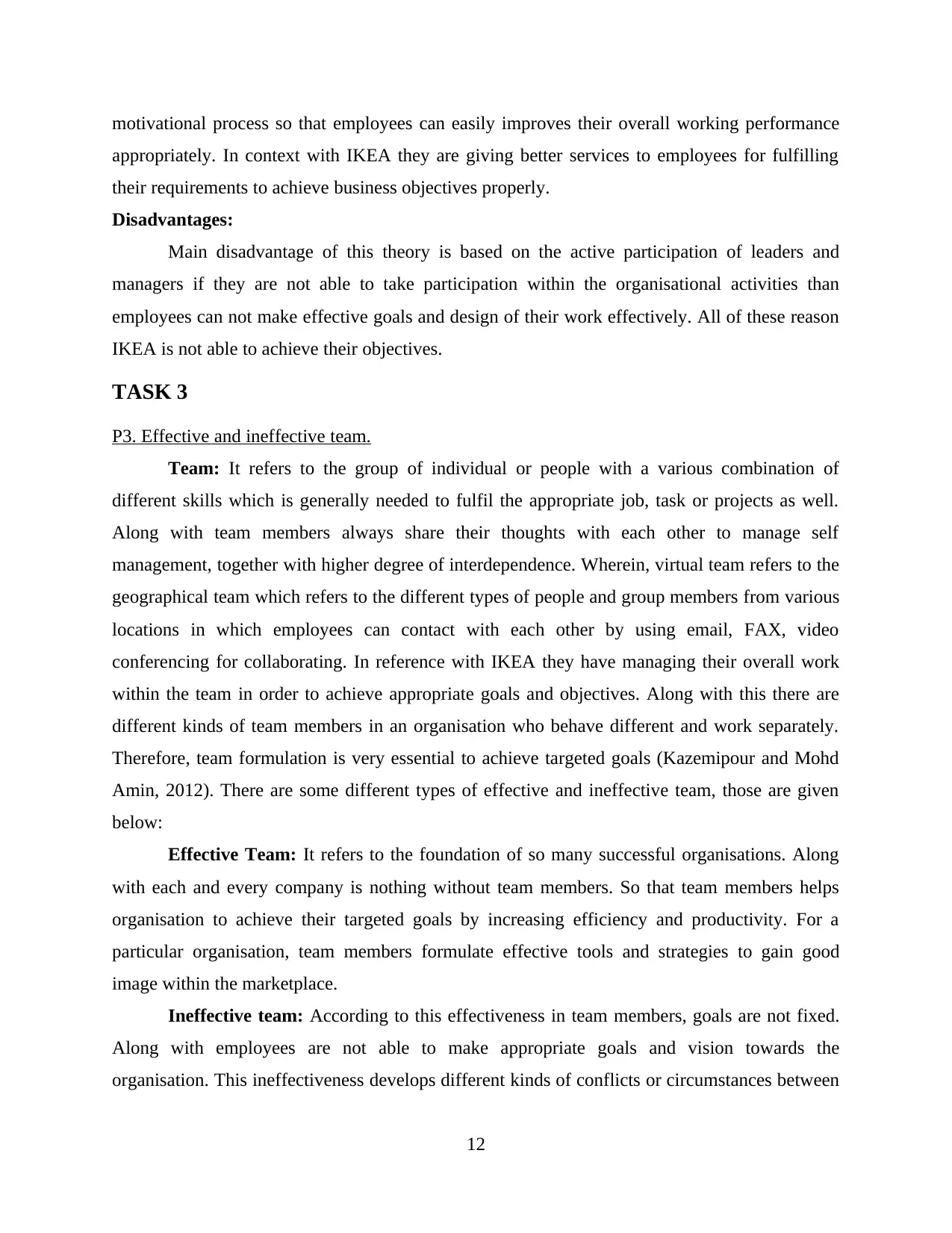
motivational process so that employees can easily improves their overall working performance
appropriately. In context with IKEA they are giving better services to employees for fulfilling
their requirements to achieve business objectives properly.
Disadvantages:
Main disadvantage of this theory is based on the active participation of leaders and
managers if they are not able to take participation within the organisational activities than
employees can not make effective goals and design of their work effectively. All of these reason
IKEA is not able to achieve their objectives.
TASK 3
P3. Effective and ineffective team.
Team: It refers to the group of individual or people with a various combination of
different skills which is generally needed to fulfil the appropriate job, task or projects as well.
Along with team members always share their thoughts with each other to manage self
management, together with higher degree of interdependence. Wherein, virtual team refers to the
geographical team which refers to the different types of people and group members from various
locations in which employees can contact with each other by using email, FAX, video
conferencing for collaborating. In reference with IKEA they have managing their overall work
within the team in order to achieve appropriate goals and objectives. Along with this there are
different kinds of team members in an organisation who behave different and work separately.
Therefore, team formulation is very essential to achieve targeted goals (Kazemipour and Mohd
Amin, 2012). There are some different types of effective and ineffective team, those are given
below:
Effective Team: It refers to the foundation of so many successful organisations. Along
with each and every company is nothing without team members. So that team members helps
organisation to achieve their targeted goals by increasing efficiency and productivity. For a
particular organisation, team members formulate effective tools and strategies to gain good
image within the marketplace.
Ineffective team: According to this effectiveness in team members, goals are not fixed.
Along with employees are not able to make appropriate goals and vision towards the
organisation. This ineffectiveness develops different kinds of conflicts or circumstances between
12
appropriately. In context with IKEA they are giving better services to employees for fulfilling
their requirements to achieve business objectives properly.
Disadvantages:
Main disadvantage of this theory is based on the active participation of leaders and
managers if they are not able to take participation within the organisational activities than
employees can not make effective goals and design of their work effectively. All of these reason
IKEA is not able to achieve their objectives.
TASK 3
P3. Effective and ineffective team.
Team: It refers to the group of individual or people with a various combination of
different skills which is generally needed to fulfil the appropriate job, task or projects as well.
Along with team members always share their thoughts with each other to manage self
management, together with higher degree of interdependence. Wherein, virtual team refers to the
geographical team which refers to the different types of people and group members from various
locations in which employees can contact with each other by using email, FAX, video
conferencing for collaborating. In reference with IKEA they have managing their overall work
within the team in order to achieve appropriate goals and objectives. Along with this there are
different kinds of team members in an organisation who behave different and work separately.
Therefore, team formulation is very essential to achieve targeted goals (Kazemipour and Mohd
Amin, 2012). There are some different types of effective and ineffective team, those are given
below:
Effective Team: It refers to the foundation of so many successful organisations. Along
with each and every company is nothing without team members. So that team members helps
organisation to achieve their targeted goals by increasing efficiency and productivity. For a
particular organisation, team members formulate effective tools and strategies to gain good
image within the marketplace.
Ineffective team: According to this effectiveness in team members, goals are not fixed.
Along with employees are not able to make appropriate goals and vision towards the
organisation. This ineffectiveness develops different kinds of conflicts or circumstances between
12
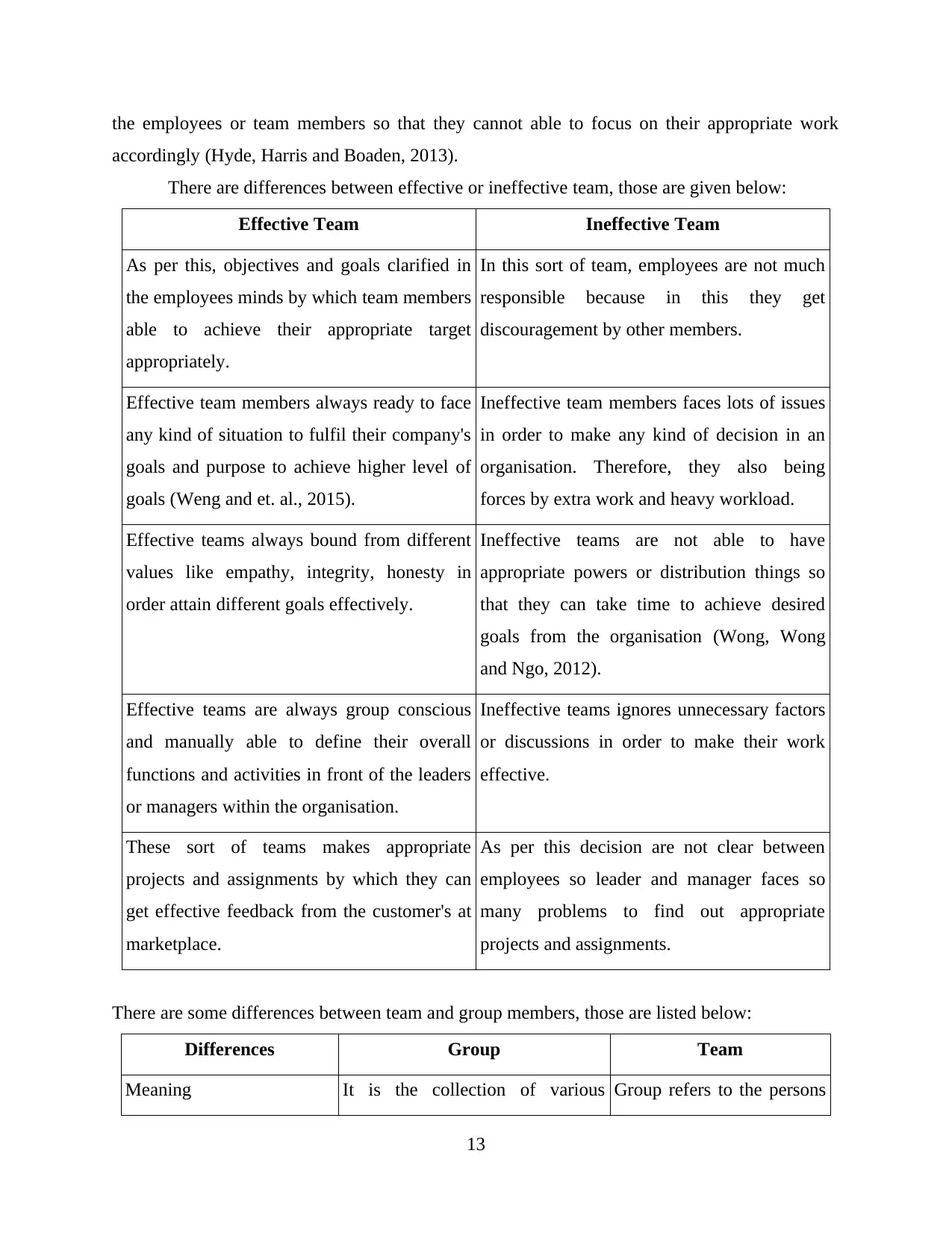
the employees or team members so that they cannot able to focus on their appropriate work
accordingly (Hyde, Harris and Boaden, 2013).
There are differences between effective or ineffective team, those are given below:
Effective Team Ineffective Team
As per this, objectives and goals clarified in
the employees minds by which team members
able to achieve their appropriate target
appropriately.
In this sort of team, employees are not much
responsible because in this they get
discouragement by other members.
Effective team members always ready to face
any kind of situation to fulfil their company's
goals and purpose to achieve higher level of
goals (Weng and et. al., 2015).
Ineffective team members faces lots of issues
in order to make any kind of decision in an
organisation. Therefore, they also being
forces by extra work and heavy workload.
Effective teams always bound from different
values like empathy, integrity, honesty in
order attain different goals effectively.
Ineffective teams are not able to have
appropriate powers or distribution things so
that they can take time to achieve desired
goals from the organisation (Wong, Wong
and Ngo, 2012).
Effective teams are always group conscious
and manually able to define their overall
functions and activities in front of the leaders
or managers within the organisation.
Ineffective teams ignores unnecessary factors
or discussions in order to make their work
effective.
These sort of teams makes appropriate
projects and assignments by which they can
get effective feedback from the customer's at
marketplace.
As per this decision are not clear between
employees so leader and manager faces so
many problems to find out appropriate
projects and assignments.
There are some differences between team and group members, those are listed below:
Differences Group Team
Meaning It is the collection of various Group refers to the persons
13
accordingly (Hyde, Harris and Boaden, 2013).
There are differences between effective or ineffective team, those are given below:
Effective Team Ineffective Team
As per this, objectives and goals clarified in
the employees minds by which team members
able to achieve their appropriate target
appropriately.
In this sort of team, employees are not much
responsible because in this they get
discouragement by other members.
Effective team members always ready to face
any kind of situation to fulfil their company's
goals and purpose to achieve higher level of
goals (Weng and et. al., 2015).
Ineffective team members faces lots of issues
in order to make any kind of decision in an
organisation. Therefore, they also being
forces by extra work and heavy workload.
Effective teams always bound from different
values like empathy, integrity, honesty in
order attain different goals effectively.
Ineffective teams are not able to have
appropriate powers or distribution things so
that they can take time to achieve desired
goals from the organisation (Wong, Wong
and Ngo, 2012).
Effective teams are always group conscious
and manually able to define their overall
functions and activities in front of the leaders
or managers within the organisation.
Ineffective teams ignores unnecessary factors
or discussions in order to make their work
effective.
These sort of teams makes appropriate
projects and assignments by which they can
get effective feedback from the customer's at
marketplace.
As per this decision are not clear between
employees so leader and manager faces so
many problems to find out appropriate
projects and assignments.
There are some differences between team and group members, those are listed below:
Differences Group Team
Meaning It is the collection of various Group refers to the persons
13
Secure Best Marks with AI Grader
Need help grading? Try our AI Grader for instant feedback on your assignments.
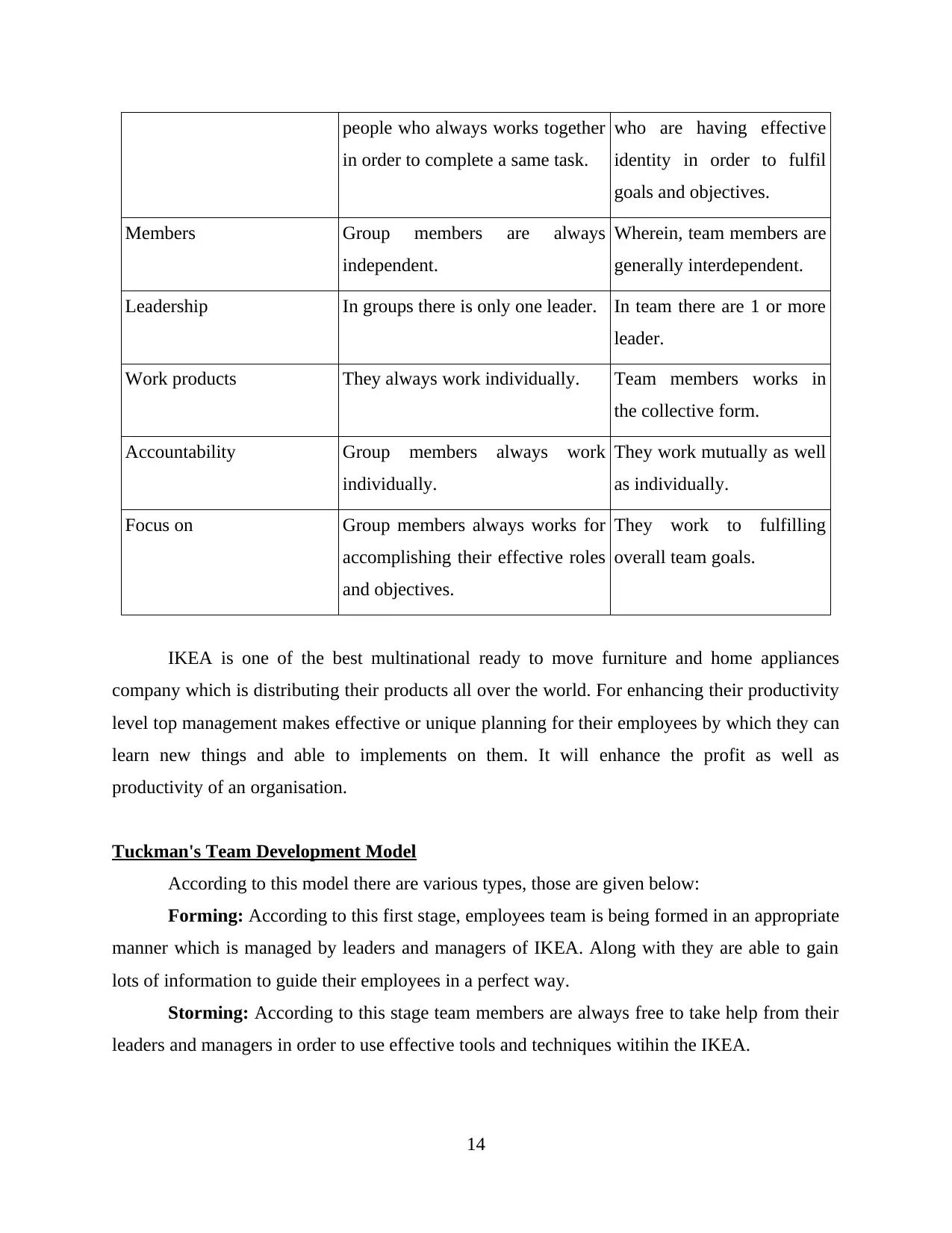
people who always works together
in order to complete a same task.
who are having effective
identity in order to fulfil
goals and objectives.
Members Group members are always
independent.
Wherein, team members are
generally interdependent.
Leadership In groups there is only one leader. In team there are 1 or more
leader.
Work products They always work individually. Team members works in
the collective form.
Accountability Group members always work
individually.
They work mutually as well
as individually.
Focus on Group members always works for
accomplishing their effective roles
and objectives.
They work to fulfilling
overall team goals.
IKEA is one of the best multinational ready to move furniture and home appliances
company which is distributing their products all over the world. For enhancing their productivity
level top management makes effective or unique planning for their employees by which they can
learn new things and able to implements on them. It will enhance the profit as well as
productivity of an organisation.
Tuckman's Team Development Model
According to this model there are various types, those are given below:
Forming: According to this first stage, employees team is being formed in an appropriate
manner which is managed by leaders and managers of IKEA. Along with they are able to gain
lots of information to guide their employees in a perfect way.
Storming: According to this stage team members are always free to take help from their
leaders and managers in order to use effective tools and techniques witihin the IKEA.
14
in order to complete a same task.
who are having effective
identity in order to fulfil
goals and objectives.
Members Group members are always
independent.
Wherein, team members are
generally interdependent.
Leadership In groups there is only one leader. In team there are 1 or more
leader.
Work products They always work individually. Team members works in
the collective form.
Accountability Group members always work
individually.
They work mutually as well
as individually.
Focus on Group members always works for
accomplishing their effective roles
and objectives.
They work to fulfilling
overall team goals.
IKEA is one of the best multinational ready to move furniture and home appliances
company which is distributing their products all over the world. For enhancing their productivity
level top management makes effective or unique planning for their employees by which they can
learn new things and able to implements on them. It will enhance the profit as well as
productivity of an organisation.
Tuckman's Team Development Model
According to this model there are various types, those are given below:
Forming: According to this first stage, employees team is being formed in an appropriate
manner which is managed by leaders and managers of IKEA. Along with they are able to gain
lots of information to guide their employees in a perfect way.
Storming: According to this stage team members are always free to take help from their
leaders and managers in order to use effective tools and techniques witihin the IKEA.
14
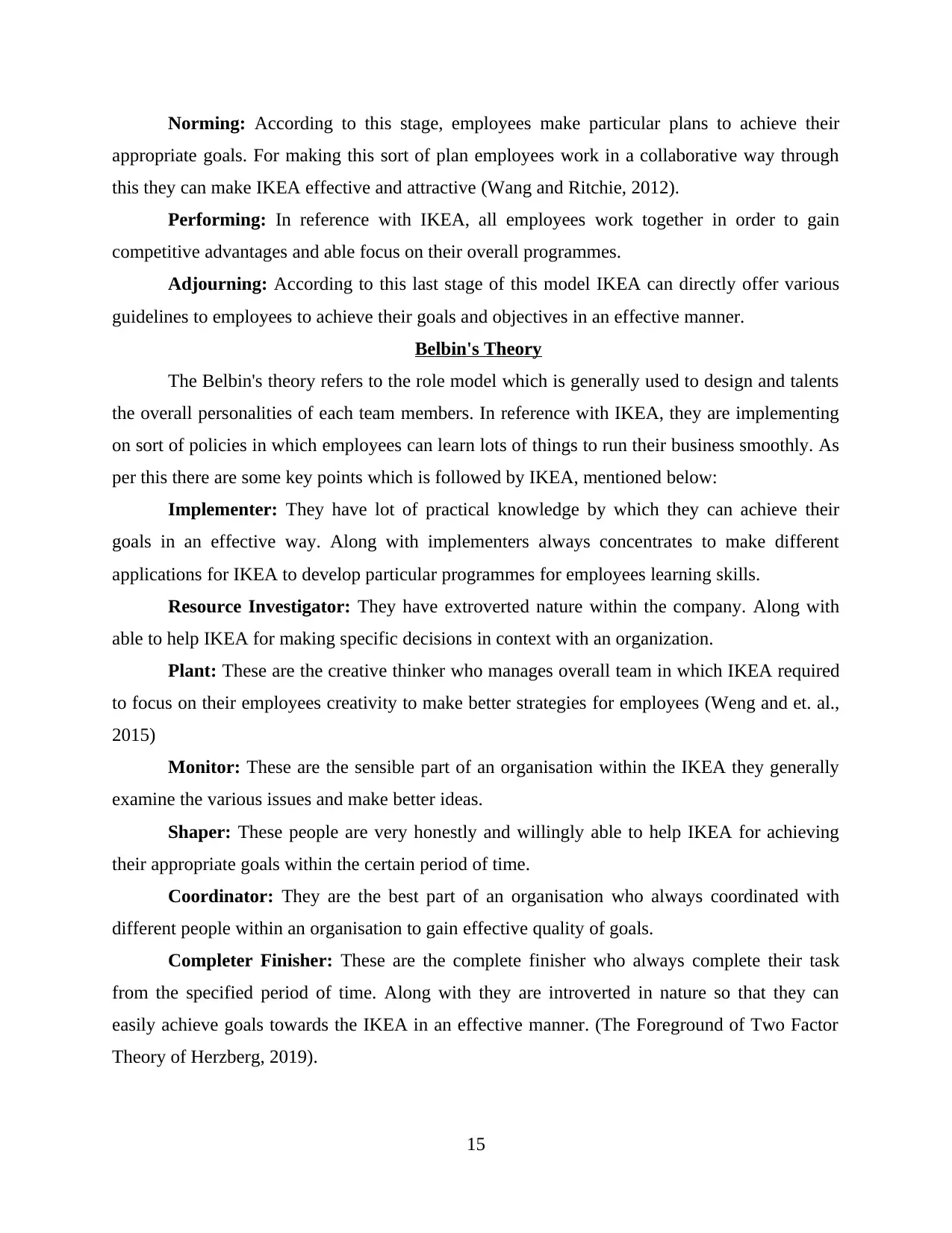
Norming: According to this stage, employees make particular plans to achieve their
appropriate goals. For making this sort of plan employees work in a collaborative way through
this they can make IKEA effective and attractive (Wang and Ritchie, 2012).
Performing: In reference with IKEA, all employees work together in order to gain
competitive advantages and able focus on their overall programmes.
Adjourning: According to this last stage of this model IKEA can directly offer various
guidelines to employees to achieve their goals and objectives in an effective manner.
Belbin's Theory
The Belbin's theory refers to the role model which is generally used to design and talents
the overall personalities of each team members. In reference with IKEA, they are implementing
on sort of policies in which employees can learn lots of things to run their business smoothly. As
per this there are some key points which is followed by IKEA, mentioned below:
Implementer: They have lot of practical knowledge by which they can achieve their
goals in an effective way. Along with implementers always concentrates to make different
applications for IKEA to develop particular programmes for employees learning skills.
Resource Investigator: They have extroverted nature within the company. Along with
able to help IKEA for making specific decisions in context with an organization.
Plant: These are the creative thinker who manages overall team in which IKEA required
to focus on their employees creativity to make better strategies for employees (Weng and et. al.,
2015)
Monitor: These are the sensible part of an organisation within the IKEA they generally
examine the various issues and make better ideas.
Shaper: These people are very honestly and willingly able to help IKEA for achieving
their appropriate goals within the certain period of time.
Coordinator: They are the best part of an organisation who always coordinated with
different people within an organisation to gain effective quality of goals.
Completer Finisher: These are the complete finisher who always complete their task
from the specified period of time. Along with they are introverted in nature so that they can
easily achieve goals towards the IKEA in an effective manner. (The Foreground of Two Factor
Theory of Herzberg, 2019).
15
appropriate goals. For making this sort of plan employees work in a collaborative way through
this they can make IKEA effective and attractive (Wang and Ritchie, 2012).
Performing: In reference with IKEA, all employees work together in order to gain
competitive advantages and able focus on their overall programmes.
Adjourning: According to this last stage of this model IKEA can directly offer various
guidelines to employees to achieve their goals and objectives in an effective manner.
Belbin's Theory
The Belbin's theory refers to the role model which is generally used to design and talents
the overall personalities of each team members. In reference with IKEA, they are implementing
on sort of policies in which employees can learn lots of things to run their business smoothly. As
per this there are some key points which is followed by IKEA, mentioned below:
Implementer: They have lot of practical knowledge by which they can achieve their
goals in an effective way. Along with implementers always concentrates to make different
applications for IKEA to develop particular programmes for employees learning skills.
Resource Investigator: They have extroverted nature within the company. Along with
able to help IKEA for making specific decisions in context with an organization.
Plant: These are the creative thinker who manages overall team in which IKEA required
to focus on their employees creativity to make better strategies for employees (Weng and et. al.,
2015)
Monitor: These are the sensible part of an organisation within the IKEA they generally
examine the various issues and make better ideas.
Shaper: These people are very honestly and willingly able to help IKEA for achieving
their appropriate goals within the certain period of time.
Coordinator: They are the best part of an organisation who always coordinated with
different people within an organisation to gain effective quality of goals.
Completer Finisher: These are the complete finisher who always complete their task
from the specified period of time. Along with they are introverted in nature so that they can
easily achieve goals towards the IKEA in an effective manner. (The Foreground of Two Factor
Theory of Herzberg, 2019).
15
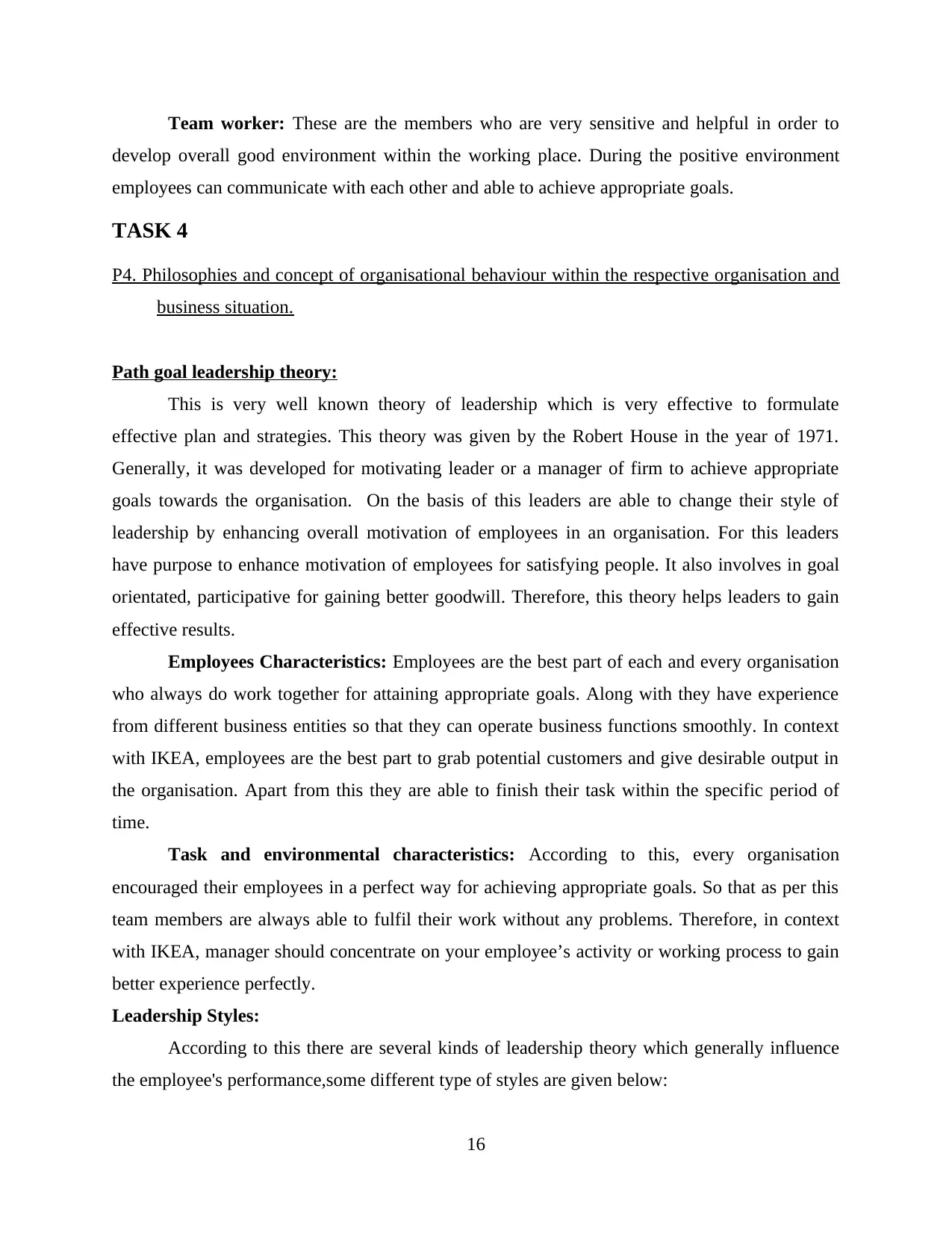
Team worker: These are the members who are very sensitive and helpful in order to
develop overall good environment within the working place. During the positive environment
employees can communicate with each other and able to achieve appropriate goals.
TASK 4
P4. Philosophies and concept of organisational behaviour within the respective organisation and
business situation.
Path goal leadership theory:
This is very well known theory of leadership which is very effective to formulate
effective plan and strategies. This theory was given by the Robert House in the year of 1971.
Generally, it was developed for motivating leader or a manager of firm to achieve appropriate
goals towards the organisation. On the basis of this leaders are able to change their style of
leadership by enhancing overall motivation of employees in an organisation. For this leaders
have purpose to enhance motivation of employees for satisfying people. It also involves in goal
orientated, participative for gaining better goodwill. Therefore, this theory helps leaders to gain
effective results.
Employees Characteristics: Employees are the best part of each and every organisation
who always do work together for attaining appropriate goals. Along with they have experience
from different business entities so that they can operate business functions smoothly. In context
with IKEA, employees are the best part to grab potential customers and give desirable output in
the organisation. Apart from this they are able to finish their task within the specific period of
time.
Task and environmental characteristics: According to this, every organisation
encouraged their employees in a perfect way for achieving appropriate goals. So that as per this
team members are always able to fulfil their work without any problems. Therefore, in context
with IKEA, manager should concentrate on your employee’s activity or working process to gain
better experience perfectly.
Leadership Styles:
According to this there are several kinds of leadership theory which generally influence
the employee's performance,some different type of styles are given below:
16
develop overall good environment within the working place. During the positive environment
employees can communicate with each other and able to achieve appropriate goals.
TASK 4
P4. Philosophies and concept of organisational behaviour within the respective organisation and
business situation.
Path goal leadership theory:
This is very well known theory of leadership which is very effective to formulate
effective plan and strategies. This theory was given by the Robert House in the year of 1971.
Generally, it was developed for motivating leader or a manager of firm to achieve appropriate
goals towards the organisation. On the basis of this leaders are able to change their style of
leadership by enhancing overall motivation of employees in an organisation. For this leaders
have purpose to enhance motivation of employees for satisfying people. It also involves in goal
orientated, participative for gaining better goodwill. Therefore, this theory helps leaders to gain
effective results.
Employees Characteristics: Employees are the best part of each and every organisation
who always do work together for attaining appropriate goals. Along with they have experience
from different business entities so that they can operate business functions smoothly. In context
with IKEA, employees are the best part to grab potential customers and give desirable output in
the organisation. Apart from this they are able to finish their task within the specific period of
time.
Task and environmental characteristics: According to this, every organisation
encouraged their employees in a perfect way for achieving appropriate goals. So that as per this
team members are always able to fulfil their work without any problems. Therefore, in context
with IKEA, manager should concentrate on your employee’s activity or working process to gain
better experience perfectly.
Leadership Styles:
According to this there are several kinds of leadership theory which generally influence
the employee's performance,some different type of styles are given below:
16
Paraphrase This Document
Need a fresh take? Get an instant paraphrase of this document with our AI Paraphraser

Achievement: As per this, managers are able to follow various steps which all are given
by company in order to encourage other employee and motivating them towards the work. So
that they can achieve their better outcomes according to their performance.
Participative: According to this leaders of IKEA, always ready to focus on their
employees activity and enhance their participative level for making organisation effective or
efficient in front of other people.
Directive: In this leaders are responsible for developing appropriate tools and techniques
for their employees which improves the overall business process of IKEA in a perfect way.
Supportive: As per this leaders are very supportive for their team so that employees can
achieve their oriented goals. In reference with IKEA, leaders are following various strategies for
gaining effective results for betterment of future.
Contingency leadership theory:
It is very essential theory and sort of approach which is generally shoes the success of a
leader but not depends on their liabilities within the organisation. Along with this there are
various factors which influence the success of managers within the process of leadership.
Therefore, it is also known as integrated model of leadership which is given by George Terry.
Basis of contingency theory:
The basis of this model and approach is vert simple, which determines the different
people with their abilities by which individuals can perform better in their appropriate interesting
field. In context with IKEA they are using this approach in order to enhance employees skills
and their knowledge for attaining appropriate goals in an effective manner. On the basis of this
leaders can play their appropriate goals and take support from their team members in an effective
manner.
In the current scenario, there are some pre determined goals in organisations by which
they can get their appropriate goals and target in an effective manner. Therefore, it is important
for IKEA to have very good organizational structure by which they can influence other people
within the marketplace. As per this manager of IKEA company is responsible to conduct
appropriate instruction or guidelines for employees to increase their particular information within
the company. So that, employees are able to gain various kinds of rewards like discounts,
increments and so on as per their good performance. Additionally, there are various factors
which are followed by IKEA, those are given below:
17
by company in order to encourage other employee and motivating them towards the work. So
that they can achieve their better outcomes according to their performance.
Participative: According to this leaders of IKEA, always ready to focus on their
employees activity and enhance their participative level for making organisation effective or
efficient in front of other people.
Directive: In this leaders are responsible for developing appropriate tools and techniques
for their employees which improves the overall business process of IKEA in a perfect way.
Supportive: As per this leaders are very supportive for their team so that employees can
achieve their oriented goals. In reference with IKEA, leaders are following various strategies for
gaining effective results for betterment of future.
Contingency leadership theory:
It is very essential theory and sort of approach which is generally shoes the success of a
leader but not depends on their liabilities within the organisation. Along with this there are
various factors which influence the success of managers within the process of leadership.
Therefore, it is also known as integrated model of leadership which is given by George Terry.
Basis of contingency theory:
The basis of this model and approach is vert simple, which determines the different
people with their abilities by which individuals can perform better in their appropriate interesting
field. In context with IKEA they are using this approach in order to enhance employees skills
and their knowledge for attaining appropriate goals in an effective manner. On the basis of this
leaders can play their appropriate goals and take support from their team members in an effective
manner.
In the current scenario, there are some pre determined goals in organisations by which
they can get their appropriate goals and target in an effective manner. Therefore, it is important
for IKEA to have very good organizational structure by which they can influence other people
within the marketplace. As per this manager of IKEA company is responsible to conduct
appropriate instruction or guidelines for employees to increase their particular information within
the company. So that, employees are able to gain various kinds of rewards like discounts,
increments and so on as per their good performance. Additionally, there are various factors
which are followed by IKEA, those are given below:
17

Responsibility: According to this, employees are responsible to take lots of work from
their managers in order to full fill their overall task by having lots of ability, talents, task and so
on. Therefore, it is very important feature for employees to grab customer's attentions towards
the appropriate work.
Integrity: It is helpful for developing ethical and safe environment in order to developing
effective working relationship with the people in an organisation. Along with it refers to the
leaders who always ready to provide different ideas to employees perfectly.
Now this can be said that IKEA company using path goals theory and philosophy in order
increase their overall productivity of firm in front of the people. Along which by using this
theory they can increase working performance of employees and they can easily achieve
different goals by getting different training and development programmes in an effective manner.
18
their managers in order to full fill their overall task by having lots of ability, talents, task and so
on. Therefore, it is very important feature for employees to grab customer's attentions towards
the appropriate work.
Integrity: It is helpful for developing ethical and safe environment in order to developing
effective working relationship with the people in an organisation. Along with it refers to the
leaders who always ready to provide different ideas to employees perfectly.
Now this can be said that IKEA company using path goals theory and philosophy in order
increase their overall productivity of firm in front of the people. Along which by using this
theory they can increase working performance of employees and they can easily achieve
different goals by getting different training and development programmes in an effective manner.
18
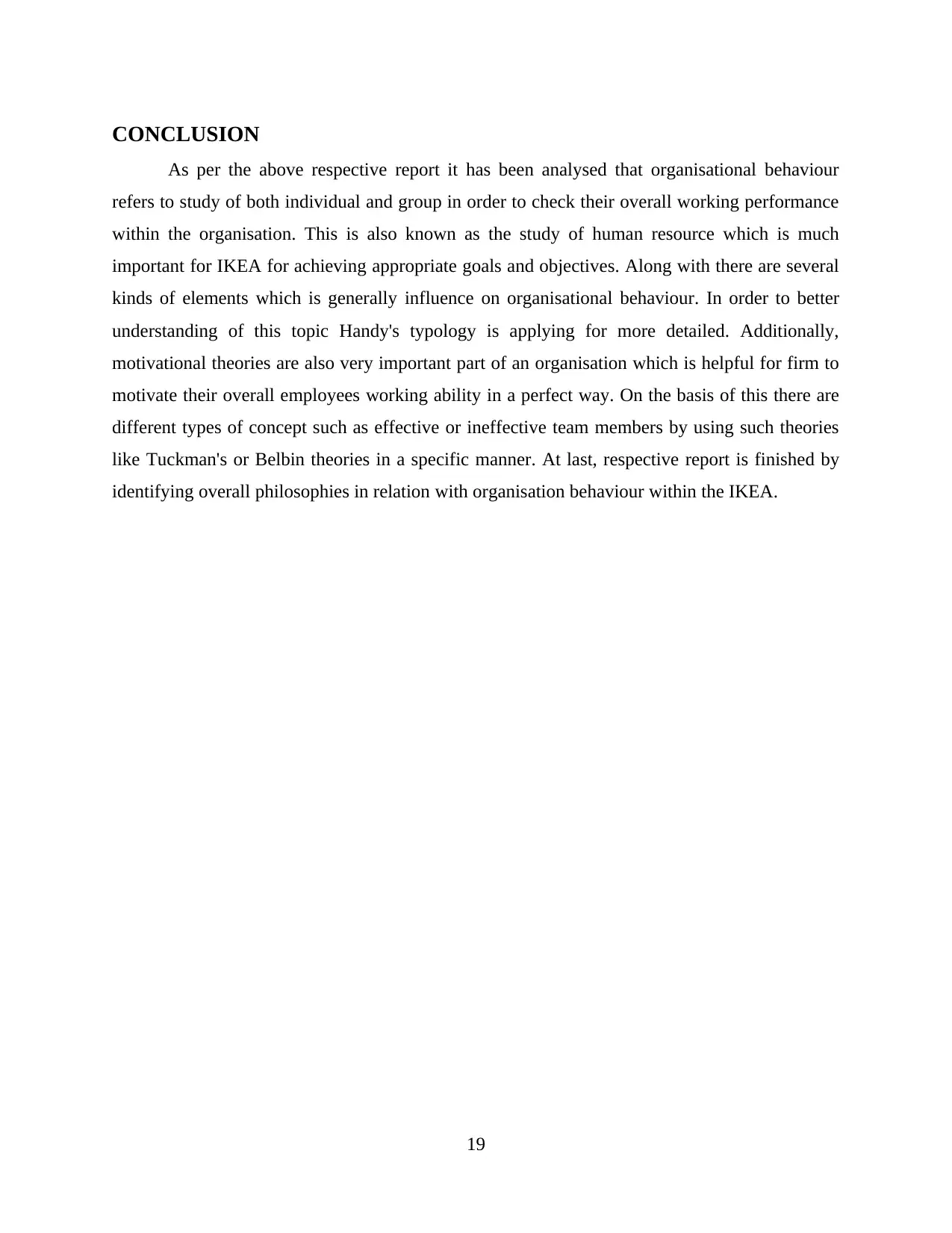
CONCLUSION
As per the above respective report it has been analysed that organisational behaviour
refers to study of both individual and group in order to check their overall working performance
within the organisation. This is also known as the study of human resource which is much
important for IKEA for achieving appropriate goals and objectives. Along with there are several
kinds of elements which is generally influence on organisational behaviour. In order to better
understanding of this topic Handy's typology is applying for more detailed. Additionally,
motivational theories are also very important part of an organisation which is helpful for firm to
motivate their overall employees working ability in a perfect way. On the basis of this there are
different types of concept such as effective or ineffective team members by using such theories
like Tuckman's or Belbin theories in a specific manner. At last, respective report is finished by
identifying overall philosophies in relation with organisation behaviour within the IKEA.
19
As per the above respective report it has been analysed that organisational behaviour
refers to study of both individual and group in order to check their overall working performance
within the organisation. This is also known as the study of human resource which is much
important for IKEA for achieving appropriate goals and objectives. Along with there are several
kinds of elements which is generally influence on organisational behaviour. In order to better
understanding of this topic Handy's typology is applying for more detailed. Additionally,
motivational theories are also very important part of an organisation which is helpful for firm to
motivate their overall employees working ability in a perfect way. On the basis of this there are
different types of concept such as effective or ineffective team members by using such theories
like Tuckman's or Belbin theories in a specific manner. At last, respective report is finished by
identifying overall philosophies in relation with organisation behaviour within the IKEA.
19
Secure Best Marks with AI Grader
Need help grading? Try our AI Grader for instant feedback on your assignments.
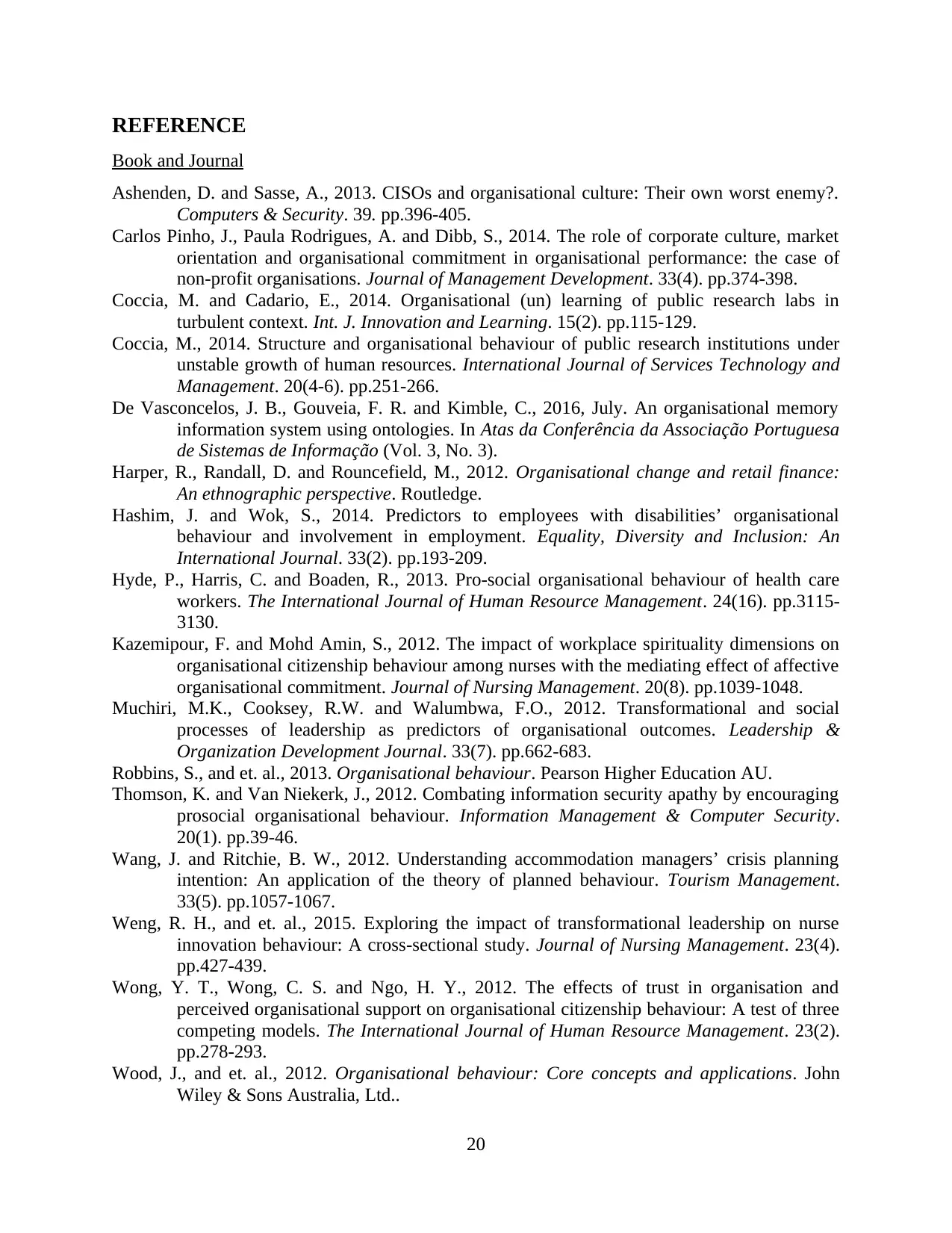
REFERENCE
Book and Journal
Ashenden, D. and Sasse, A., 2013. CISOs and organisational culture: Their own worst enemy?.
Computers & Security. 39. pp.396-405.
Carlos Pinho, J., Paula Rodrigues, A. and Dibb, S., 2014. The role of corporate culture, market
orientation and organisational commitment in organisational performance: the case of
non-profit organisations. Journal of Management Development. 33(4). pp.374-398.
Coccia, M. and Cadario, E., 2014. Organisational (un) learning of public research labs in
turbulent context. Int. J. Innovation and Learning. 15(2). pp.115-129.
Coccia, M., 2014. Structure and organisational behaviour of public research institutions under
unstable growth of human resources. International Journal of Services Technology and
Management. 20(4-6). pp.251-266.
De Vasconcelos, J. B., Gouveia, F. R. and Kimble, C., 2016, July. An organisational memory
information system using ontologies. In Atas da Conferência da Associação Portuguesa
de Sistemas de Informação (Vol. 3, No. 3).
Harper, R., Randall, D. and Rouncefield, M., 2012. Organisational change and retail finance:
An ethnographic perspective. Routledge.
Hashim, J. and Wok, S., 2014. Predictors to employees with disabilities’ organisational
behaviour and involvement in employment. Equality, Diversity and Inclusion: An
International Journal. 33(2). pp.193-209.
Hyde, P., Harris, C. and Boaden, R., 2013. Pro-social organisational behaviour of health care
workers. The International Journal of Human Resource Management. 24(16). pp.3115-
3130.
Kazemipour, F. and Mohd Amin, S., 2012. The impact of workplace spirituality dimensions on
organisational citizenship behaviour among nurses with the mediating effect of affective
organisational commitment. Journal of Nursing Management. 20(8). pp.1039-1048.
Muchiri, M.K., Cooksey, R.W. and Walumbwa, F.O., 2012. Transformational and social
processes of leadership as predictors of organisational outcomes. Leadership &
Organization Development Journal. 33(7). pp.662-683.
Robbins, S., and et. al., 2013. Organisational behaviour. Pearson Higher Education AU.
Thomson, K. and Van Niekerk, J., 2012. Combating information security apathy by encouraging
prosocial organisational behaviour. Information Management & Computer Security.
20(1). pp.39-46.
Wang, J. and Ritchie, B. W., 2012. Understanding accommodation managers’ crisis planning
intention: An application of the theory of planned behaviour. Tourism Management.
33(5). pp.1057-1067.
Weng, R. H., and et. al., 2015. Exploring the impact of transformational leadership on nurse
innovation behaviour: A cross‐sectional study. Journal of Nursing Management. 23(4).
pp.427-439.
Wong, Y. T., Wong, C. S. and Ngo, H. Y., 2012. The effects of trust in organisation and
perceived organisational support on organisational citizenship behaviour: A test of three
competing models. The International Journal of Human Resource Management. 23(2).
pp.278-293.
Wood, J., and et. al., 2012. Organisational behaviour: Core concepts and applications. John
Wiley & Sons Australia, Ltd..
20
Book and Journal
Ashenden, D. and Sasse, A., 2013. CISOs and organisational culture: Their own worst enemy?.
Computers & Security. 39. pp.396-405.
Carlos Pinho, J., Paula Rodrigues, A. and Dibb, S., 2014. The role of corporate culture, market
orientation and organisational commitment in organisational performance: the case of
non-profit organisations. Journal of Management Development. 33(4). pp.374-398.
Coccia, M. and Cadario, E., 2014. Organisational (un) learning of public research labs in
turbulent context. Int. J. Innovation and Learning. 15(2). pp.115-129.
Coccia, M., 2014. Structure and organisational behaviour of public research institutions under
unstable growth of human resources. International Journal of Services Technology and
Management. 20(4-6). pp.251-266.
De Vasconcelos, J. B., Gouveia, F. R. and Kimble, C., 2016, July. An organisational memory
information system using ontologies. In Atas da Conferência da Associação Portuguesa
de Sistemas de Informação (Vol. 3, No. 3).
Harper, R., Randall, D. and Rouncefield, M., 2012. Organisational change and retail finance:
An ethnographic perspective. Routledge.
Hashim, J. and Wok, S., 2014. Predictors to employees with disabilities’ organisational
behaviour and involvement in employment. Equality, Diversity and Inclusion: An
International Journal. 33(2). pp.193-209.
Hyde, P., Harris, C. and Boaden, R., 2013. Pro-social organisational behaviour of health care
workers. The International Journal of Human Resource Management. 24(16). pp.3115-
3130.
Kazemipour, F. and Mohd Amin, S., 2012. The impact of workplace spirituality dimensions on
organisational citizenship behaviour among nurses with the mediating effect of affective
organisational commitment. Journal of Nursing Management. 20(8). pp.1039-1048.
Muchiri, M.K., Cooksey, R.W. and Walumbwa, F.O., 2012. Transformational and social
processes of leadership as predictors of organisational outcomes. Leadership &
Organization Development Journal. 33(7). pp.662-683.
Robbins, S., and et. al., 2013. Organisational behaviour. Pearson Higher Education AU.
Thomson, K. and Van Niekerk, J., 2012. Combating information security apathy by encouraging
prosocial organisational behaviour. Information Management & Computer Security.
20(1). pp.39-46.
Wang, J. and Ritchie, B. W., 2012. Understanding accommodation managers’ crisis planning
intention: An application of the theory of planned behaviour. Tourism Management.
33(5). pp.1057-1067.
Weng, R. H., and et. al., 2015. Exploring the impact of transformational leadership on nurse
innovation behaviour: A cross‐sectional study. Journal of Nursing Management. 23(4).
pp.427-439.
Wong, Y. T., Wong, C. S. and Ngo, H. Y., 2012. The effects of trust in organisation and
perceived organisational support on organisational citizenship behaviour: A test of three
competing models. The International Journal of Human Resource Management. 23(2).
pp.278-293.
Wood, J., and et. al., 2012. Organisational behaviour: Core concepts and applications. John
Wiley & Sons Australia, Ltd..
20
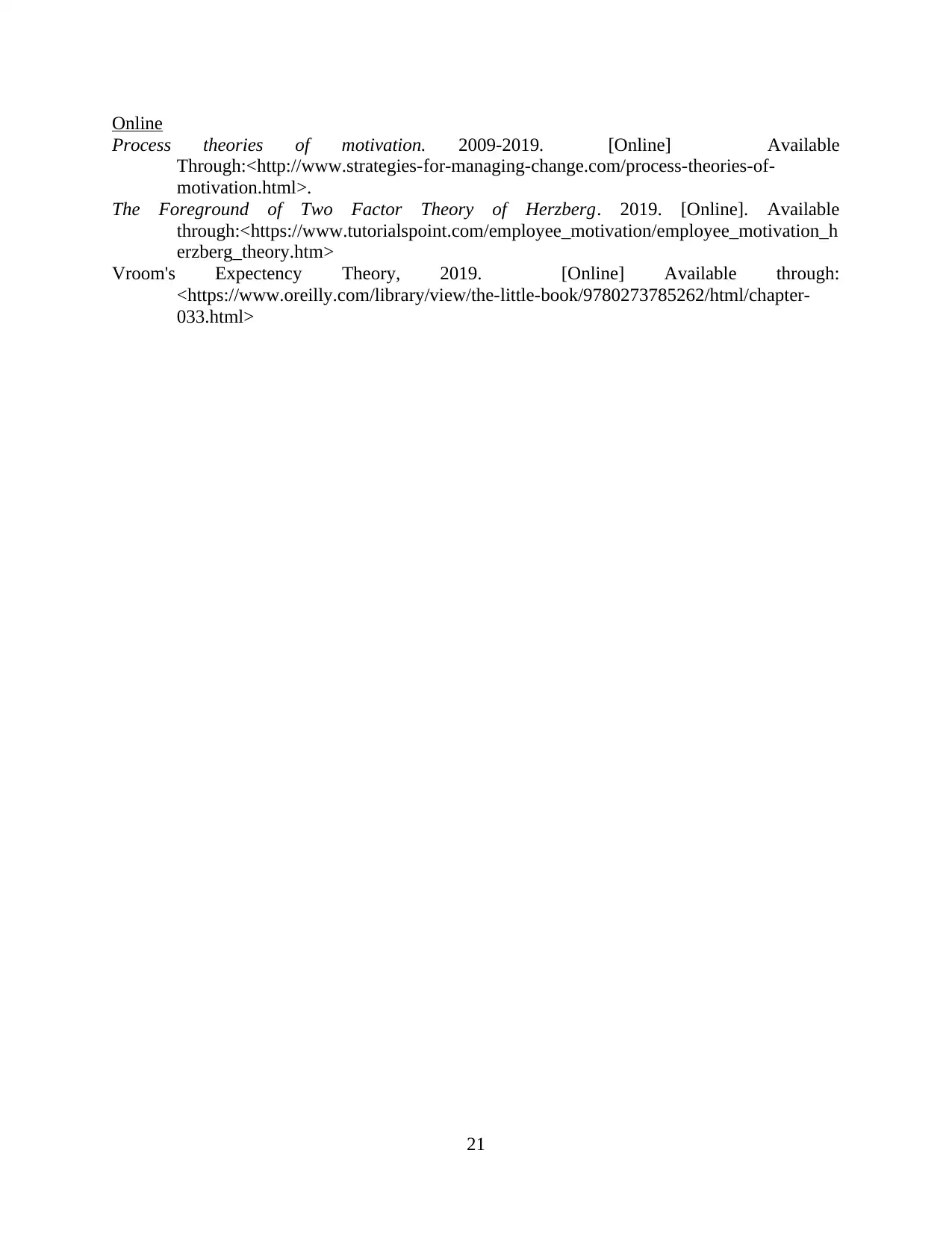
Online
Process theories of motivation. 2009-2019. [Online] Available
Through:<http://www.strategies-for-managing-change.com/process-theories-of-
motivation.html>.
The Foreground of Two Factor Theory of Herzberg. 2019. [Online]. Available
through:<https://www.tutorialspoint.com/employee_motivation/employee_motivation_h
erzberg_theory.htm>
Vroom's Expectency Theory, 2019. [Online] Available through:
<https://www.oreilly.com/library/view/the-little-book/9780273785262/html/chapter-
033.html>
21
Process theories of motivation. 2009-2019. [Online] Available
Through:<http://www.strategies-for-managing-change.com/process-theories-of-
motivation.html>.
The Foreground of Two Factor Theory of Herzberg. 2019. [Online]. Available
through:<https://www.tutorialspoint.com/employee_motivation/employee_motivation_h
erzberg_theory.htm>
Vroom's Expectency Theory, 2019. [Online] Available through:
<https://www.oreilly.com/library/view/the-little-book/9780273785262/html/chapter-
033.html>
21
1 out of 24
Related Documents
Your All-in-One AI-Powered Toolkit for Academic Success.
+13062052269
info@desklib.com
Available 24*7 on WhatsApp / Email
![[object Object]](/_next/static/media/star-bottom.7253800d.svg)
Unlock your academic potential
© 2024 | Zucol Services PVT LTD | All rights reserved.




